Subjective vs. Objective Essay: Examples, Writing Guides, & Topics
Subjective or objective essay writing is a common task students have to deal with. On the initial stage of completing the assignment, you should learn how to differentiate these two types of papers. Their goals, methods, as well as language, tone, and voice, are different.
A subjective essay focuses on the writer’s personal opinion, while an objective one represents valid facts. So, be careful when composing an objective paragraph or paper. Don’t let your beliefs take over real arguments supported by substantial evidence.
In short, differences between these styles concern the following:
- The ground for objective essays is facts; for subjective essays – personal opinions and beliefs.
- Objective papers report the findings from scientific sources, while subjective ones describe the writer’s thoughts.
- The objective essay’s goal is to help the reader make a decision. Subjective writing aims to reflect the author’s vision of the issue.
So, if you face this task for the first time, you may need some explanations. Custom-writing.org experts prepared a list of tips on how to write objective and subjective essays. Some topics, as well as objective and subjective writing examples, will also be useful.
- 🆚 Subjective vs. Objective

🔗 References
🆚 subjective vs. objective essays.
First and foremost, let’s find out the critical differences between the writing styles. Take a look at the following table and shed light on this issue.
| The information in the paper is based solely on facts. | Such essays present the personal opinion of the author on the topic given. |
| They are commonly used in books, news reports, encyclopedias, political reports, etc. | One can notice personal information in comments, blog articles, biographies, etc. |
| Objective essays should help make decisions, as it presents unbiased information about the topic. | Aims to present a personal reading of the situation. It is not used in decision-making. |
An objective essay is a presentation of the material with no independent opinion involved. Only facts matter in this paper, and only facts can back up some assertions. Writing subjective essays implies introducing your standpoint on a particular problem.
📋 How to Write an Objective Essay
Writing any essay consists of three parts: preparation, the actual writing, and revision. During the first one, you need to decide on your topic and do a little research. You can see how it looks in a real example.
Objective Essay Example: The Portrayal of Odysseus
In Odyssey, Homer portrays Odysseus, the king of Ithaca, as the true epic hero. The depiction of Odysseus is thoughtfully knitted together with the themes of love and loyalty that further magnify it, painting a holistic picture of a long 10-year journey home. Although it can be argued that some of Odysseus’s personality traits he displays cannot be applied to a true hero, he is still depicted following a very specific heroic archetype.
Now, let’s get into more detail!
Objective Essay Topics
If you’ve decided to write an objective essay, you need to come up with a topic. The topic gives a reader a brief overview of what will be covered in the paper.
Here are ten great examples:
- While the differences between Italy and Spain are evident, the resemblances are striking.
- There are several similarities between the movies “Deep Impact” and “Armageddon.”
- Compare and contrast the capitals of two English-speaking countries.
- Somatic symptoms in people with PTSD can be influenced by age, gender, and avoidance.
- Some might argue, but being overweight carries a social stigma.
- Environmental factors contribute to the phenotypic expression of psychological disorders.
- Although the exact reason remains unclear, depression is affected by sex, gender, hormonal changes, and age.
- When comparing and contrasting the Bible and Quran, it seems that they have more similarities than differences.
- Musical ability is the result of influence on the person from outside.
- In comparison to extroverts, introverts draw power from within themselves to use it in future activities.
Objective Essay Structure
We shall continue with exploring an essay structure. Note that the parts described below are essential for any essay.
- Introduction . The introduction is usually the part that broadly describes the topic and gets the interest of the reader. This part of the paper should cover some background information and present the purpose.
- Hypothesis . In case your essay has one, state it in your introduction. A hypothesis includes information about how you intend to prove or refute the claim. It briefly describes the way you intend to do so.
- Arguments . Present one side of the argument. In the next paragraph, present the opposing one, using such words as “however,” “nevertheless,” and “although.” The task is to provide the readers with two sides of the argument.
- Evidence . Provide the evidence for all of your points. Keep the balance in providing proof and refutal. Omit your personal opinion, rather than include the evidence you find informative and convincing.
- Conclusion . Summarize the arguments both for and against the position. While remaining objective, shortly go over the information you presented as evidence. If the instructions require a personal opinion, in conclusion, you might write one. In other cases, briefly recap the parts of the essay. Shorten sentence generator would be greatly beneficial in such endeavor.
📜 How to Write a Subjective Essay
As we’ve mentioned earlier, a subjective essay represents the author’s vision of a particular issue. You have an opportunity to introduce your point of view without supporting your ideas with evidence from the primary sources. However, make sure your arguments are still logical and adequate.
Now see how to write a subjective essay in the sections below.
Subjective Writing Example
A well-chosen topic is the vital determinant of a successful essay. Yet, the process of selecting an idea for your paper might be challenging. That’s why you may find our example helpful.
The rapid pace of development of modern technologies increases the demand for oil and gas every year. A considerable amount of these resources is necessary to maintain both industrial enterprises and private equipment. Despite active production, there are still many unexplored places on Earth, potentially rich in oil and gas deposits. However, while making them public would help solve the existing problem, I’m afraid I disagree with this proposal.
Subjective Essay Topics
Check our list of subjective essay topics, choose the one you like the most, or inspire and come up with your idea!
- The fake and too glamorous life presented in social media leads to the development of an inferiority complex among teenagers.
- The information flows within the country should not be controlled by the governments.
- Since developed nations provoked the climate crisis, they should take full responsibility for their past actions and reduce carbon emissions in the atmosphere.
- Cyberbullying should be a matter of the same importance as physical abuse.
- Remote learning opens more opportunities and expands the students’ horizons.
- Instead of catching up with fashion trends, it is better to develop your unique style.
- People should have enough rest to reduce the levels of anxiety and decrease the chances of depression.
- Studying abroad is an experience worth trying.
- Planning and scheduling are perfect strategies to deal with procrastination.
- While applying for a job position, work experience is more significant than having a degree.
📝 Subjective Essay Structure
When you deal with this task, you have full freedom of choice. You can decide for yourself what idea to support and what arguments to present. Still, you have to structure even a subjective essay properly.
Here are the elements you have to include in your paper:
- grab the readers’ attention;
- introduce your subject;
- state your position in the thesis statement.
Important note: your thesis should be clear and straightforward. Let your audience understand your opinion.
- Description . Dive deeper into your topic and describe your issue in detail. However, don’t go too far. Avoid including irrelevant facts and unnecessary information. Follow the principle “quality over quantity” to keep your reader engaged.
- Opinion . After describing your issue, move to the most crucial part of your essay—opinion. State it clearly and concisely. Although you don’t need to provide any evidence from scholarly sources, your ideas should be supported by substantial arguments or examples from your personal life.
- Conclusion . In the last paragraph of your subjective essay, restate your thesis statement. Don’t introduce any other ideas here. To make your paper more dynamic, ask a provocative question at the end. It may motivate your reader for further investigation of your subject.
A helpful tip:
Before submitting your work, make sure it is coherent. Check if all of your ideas follow the logical flow. To avoid redundancy and wordiness, mix shorter sentences with longer ones and apply transitional phrases. Polish your essay, turn it in, and wait for your perfect grade.
Thanks for reading the page! Share it with your peers who may need some guidance as well. Our writers are ready to explain any other essay type , not only objective or subjective ones.
Learn more on this topic:
- How to Write an Expository Essay in Simple Steps
- Nursing Reflective Essay Example and Guidelines for Students
- Essay on Dengue Fever: How to Write + Free Examples
- French Essay Writing: How-to Guide and Examples
- How to Write a Rebuttal Essay: Jackie Michael, Pen and the Pad
- Writing Objectively: OWLL, Massey University
- Subjective vs Objective: Difference and Comparison, Diffen
- Objective and Subjective Claims: TIP Sheet, Butte College
- Evidence: The Writing Center, University of North Carolina at Chapel Hill
- Organizing Your Argument: Purdue Online Writing Lab, College of Liberal Arts, University of Purdue
- Argumentative Paper Format: Courtesy the Odegaard Writing & Research Center, University of Washington
- How Do I Write an Intro, Conclusion, & Body Paragraph: LSA Sweetland Center for Writing, the University of Michigan
- Share to Facebook
- Share to Twitter
- Share to LinkedIn
- Share to email

Writing All About Me paragraph is probably one of the most usual assignments. For example, students might write it when entering an academic institution. Such work gives an opportunity to introduce yourself, your skills, and goals. However, it is not the only possible situation.

Coral reefs can be called one of the most amazing things created by nature. These structures can be found in tropical and temperate waters. Like many other unique natural phenomena, coral reefs are influenced by human activity these days. This negative impact is one of the significant issues to consider when...

An ambition essay focuses on one’s strong desire to achieve success in one or several areas. It might be one’s career, finance, family, art, health, or all at once. Writing an ambition essay, you might want to consider your own life or examples from the world literature. You can describe...
![what is objective and essay Essay for Primary School: Simple Guide for Kids [with Samples]](https://custom-writing.org/blog/wp-content/uploads/2020/12/pupils-raising-hand-classroom-284x153.jpg)
The age of primary school students ranges from 5 to 11 years. At this stage of education, children start developing their writing skills. They make their first steps to analyzing and proving their points of view. Besides, they study how to write an essay for elementary school. Correctly preparing all...

Canadian identity is something that has become really important for many Canadians in the past fifty years. Canada is a big, multinational country with its own traditions, culture, and history. However, because of quite a large number of foreigners and even Americans, its culture and people are associated with the...

Let’s say you received a task to write an essay about cars. The topic might be interesting for you, but you may still have no idea how to organize your paper. Well, this article is for you.

Smoking can be viewed as one of the trendy habits. Numerous teenagers try it since they think that it is cool or can help them socialize. Often students start smoking due to stress or mental illnesses. But is it okay? Educators tend to give different written assignments, which may disclose...
![what is objective and essay Child Labor Essay: Thesis, Examples, & Writing Guide [2024]](https://custom-writing.org/blog/wp-content/uploads/2020/12/child-working-in-cambodia-e1565628499749-284x153.jpg)
Children have always been apprentices and servants all over human history. However, the Industrial Revolution increased the use of child labor in the world. It became a global problem that is relevant even today when such employment is illegal.

Dissertation critique writing develops the students’ critical and logical thinking abilities. When composing, the students learn to analyze the works conducted by other researchers. To critique a dissertation, you should: In this article, we will discuss the aspects of the dissertation critique writing in detail. Our experts gathered essential tips...

An opinion essay is a formal piece of writing which presents the author’s point of view on a particular subject supported by reasoning and examples. The opposing viewpoint is also suggested, but it is followed by arguments that show its inconsistency. Take a look at the guide prepared by Custom-writing experts to...

So, you need to accomplish your discursive essay writing. The typical questions most students ask are: How do you write it? What is discursive essay? A discursive essay is an academic paper that involves a discussion on a particular topic. It is usually assigned to college students. You may be...

How to write a narrative essay? To do that, you need to know what a narrative essay is. It is an academic text usually written as a story and containing all the usual elements of a story. Narrative essays are often personal, experiential, and creative. Still, they should be made...
Very helpful to make my assignment. Thank you so much!

Glad to know that. Thank you very much, Farhana!
Subjective and reflective.
That’s right, Raj 🙂
Thank you for this information. I submitted my subjective essay, which was rejected by my teacher for lack of an attractive hook. After reading your info on writing subjective essays, I know what I should change in my paper to get a good grade.
Thank you so sweet for these wonderful tips for objective essays! I love your blog, and it’s really helpful one online! Keep it up!
This is what I need to complete my paper. Your subjective essay writing secrets are appropriate for students who can’t cope with their essays themselves. Even those who write a paper for the first time will complete their subjective essays without any problems.
I really appreciate your help in posting all this information for students — this time you’ve taught me how to write an objective essay. You’re real specialists in writing all types of papers!
What is Objective Writing? Why Neutral Language Matters
What is objective writing? Master the skill of delivering unbiased information effectively with proven techniques and examples.
In today’s world, the way we present ideas and data can shape opinions, influence decisions, and impact the world around us. One of the most important principles of communication is objectivity. Objective writing is writing that presents information in a neutral and unbiased way. This means avoiding personal opinions, beliefs, or biases. It also means avoiding using emotional language or making subjective statements. Objective writing is typically clearer and easier to understand than subjective writing. It is also seen as more credible and trustworthy. This is because readers know that the writer is not trying to persuade them or influence their opinions.
Related article: Mastering Critical Reading: Uncover The Art Of Analyzing Texts
In a world where there is so much information available, it is more important than ever to be able to distinguish between objective and subjective writing. Objective writing is essential for fostering critical thinking and making informed decisions. This article will explore the importance of objective writing and its role in communication. We will look at how objective writing can be used to foster credibility, deliver accurate information, and promote critical thinking.
What Is Objective Writing?
Objective writing is a style of writing that presents information in a neutral and unbiased manner, without expressing personal opinions, emotions, or beliefs. The primary goal of objective writing is to provide facts, evidence, and logical reasoning to inform the reader without trying to persuade or influence their opinion.
About the question “What is objective writing?”, the author, in this kind of writing, strives to eliminate any potential bias, avoid making value judgments, and maintain a professional and impartial tone. This type of writing is commonly used in news reporting, scientific research papers, academic essays , and other forms of non-fiction writing.
Benefits Of Writing Objectively
Clarity and Understanding: Objective writing presents information in a clear and unbiased manner, allowing readers to conceive the facts without being influenced by the writer’s personal opinions or emotions. This promotes a deeper understanding of the subject matter.
Credibility and Trustworthiness: Objective writing enhances the credibility of the writer and the content. When information is presented without bias, readers are more likely to trust the accuracy and reliability of the material.
Unbiased Evaluation: Objectivity enables fair evaluation of different viewpoints, arguments, and evidence. It allows readers to form their own opinions based on the presented facts, rather than being persuaded by the writer’s subjective views.
Professionalism in Academic and Formal Writing: In academic and formal settings, objective writing is expected as it upholds the standards of professionalism and integrity in research, essays, and reports.
Conflict Resolution: Objective writing is particularly valuable in discussions and debates, as it helps to reduce conflicts by focusing on facts rather than personal feelings or biases.
Avoiding Stereotypes and Prejudices: Writing objectively helps to avoid reinforcing stereotypes and prejudices, promoting a more inclusive and open-minded perspective.
Enhanced Critical Thinking: By analyzing information objectively, writers and readers can engage in deeper critical thinking, questioning assumptions, and considering alternative viewpoints.
Appropriate in Scientific and Technical Fields: In scientific and technical writing, objectivity is essential to maintain the accuracy and validity of research findings and technical information.
Global Audience Accessibility: Objective writing is more accessible to a diverse global audience, as it transcends cultural and individual differences, making the content relevant to a broader readership.
Ethical Reporting: Journalists and reporters strive for objectivity in their news reporting to provide unbiased and truthful information to the public, upholding ethical standards in journalism.
Overall, writing objectively fosters transparency, fairness, and respect for differing perspectives, contributing to more informed, trustworthy, and inclusive communication.
Subjectivity Writing
Subjectivity and objectivity are two fundamental aspects of writing that influence how information is presented and perceived. Subjectivity refers to the presence of personal opinions, feelings, and biases in writing. It involves the writer’s perspective, emotions, and interpretations, which can impact how they convey information to the reader.
What Is Subjective Writing?
Subjective writing is a style of writing where the author expresses their personal opinions, emotions, and viewpoints on a particular subject. In subjective writing, the author’s feelings, beliefs, and individual experiences play a significant role in shaping the content. This type of writing often uses first-person pronouns, such as “I” or “we,” and employs emotional language to convey the author’s thoughts and emotions.
Subjective writing is prevalent in creative writing, personal essays, memoirs, and certain types of journalistic pieces, such as opinion columns or editorials. It allows writers to connect with the reader on a more personal level, sharing their unique perspectives and inviting the audience to empathize with their point of view.
The Difference Between Objective And Subjective Writing
It’s essential to recognize that both objective and subjective writing have their place in various contexts. Objective writing provides factual information and encourages critical thinking, while subjective writing allows for self-expression and emotional engagement. The choice between the two depends on the writer’s intentions, the subject matter, and the target audience.
Understanding the difference between objective and subjective writing enables writers to choose the appropriate style based on their intended purpose and the expectations of their audience. It also empowers readers to identify when they are encountering subjective content and approach it with a discerning mindset, acknowledging the presence of the author’s perspective.
| Tone | Neutral and impartial | Personal and emotional |
| Perspective | Third-person or no personal pronouns | First-person and personal pronouns |
| Bias | Minimizes or eliminates bias | Embraces author’s bias |
| Purpose | Inform and present facts | Express opinions and emotions |
| Use of evidence | Relies on evidence and data | May rely on personal experience |
| Language and style | Formal and professional | Informal and more engaging |
| Common applications | News reporting, scientific writing | Creative writing, personal essays |
| Examples | Textbook, research paper | Opinion column, personal journal |
Elements Of Objective Writing
Objective writing is characterized by its neutral and unbiased approach to presenting information. Writers strive to eliminate personal biases and emotions, focusing on factual accuracy and logical reasoning. Several key elements contribute to achieving objectivity in writing:
Avoiding Personal Pronouns
Objective writing minimizes the use of personal pronouns like “I,” “we,” or “you.” By avoiding these pronouns, the writer maintains a level of distance between themselves and the content, making it less likely for their personal opinions or biases to influence the information presented. Instead of writing, “I believe that,” or “In my opinion,” the objective writer would present the information without explicitly inserting themselves into the narrative. For example, “According to research,” or “Studies indicate that.”
Focusing On Facts, Not Emotions Or Opinions
Objective writing prioritizes the presentation of verifiable facts, evidence, and data over personal emotions or opinions. The writer should refrain from using emotionally charged language or expressing their feelings about the subject matter. Instead, they rely on evidence-based information to support their claims. When presenting an argument or discussing a topic, the focus is on logical reasoning and empirical support rather than emotional persuasion.
Using An Active Voice And Ergative Verbs
The active voice is preferred in objective writing because it clearly identifies the subject and the action they are performing. This contributes to clarity and directness in the writing. In contrast, the passive voice can sometimes be used to obscure responsibility or agency, potentially leading to less objective writing. Ergative verbs, which don’t require an object to complete their meaning, can also help make sentences more concise and focused.
Example (Active Voice): “The committee made the decision.” Example (Passive Voice): “The decision was made by the committee.”
Referencing Sources For Evidence And Support
Objective writing relies heavily on evidence and support from reputable sources. By referencing and citing authoritative works, research studies, experts, and reliable data, the writer reinforces the credibility of their writing. These citations also allow readers to verify the information independently, adding transparency and accountability to the content.
Maintaining A Neutral Tone In The Writing
A neutral tone is crucial in objective writing. The language used should be professional, impartial, and devoid of emotional bias. The writer should avoid overly positive or negative language that could sway the reader’s perception. Instead, the content should present information objectively, allowing the readers to draw their conclusions based on the facts and evidence provided.
Example (Neutral Tone): “The study findings suggest a correlation between X and Y, according to the researchers’ analysis.”
Common Examples Of Objective Writing
Objective writing fosters transparency, credibility, and the dissemination of reliable information across various domains, contributing to an informed and knowledgeable society. This type of writing has distinct purposes: ensuring clear communication in instruction manuals, providing unbiased information in news reporting, and maintaining scientific rigor in natural science reports.
Instruction Manual
Instruction manuals are a classic example of objective writing. These documents provide step-by-step guidance on how to use a product or perform a specific task. Objective writing in instruction manuals focuses on clarity, precision, and neutrality. It avoids subjective language and personal opinions, instead using concise and straightforward language to ensure readers can follow the instructions accurately. The emphasis is on providing clear directions and information, leaving no room for ambiguity or misinterpretation.
Example (Objective Writing in an Instruction Manual): “Insert the round end of the cable into the designated port until you hear a click.”
News Reporting
News reporting is one of the primary domains where objective writing is crucial. Journalists aim to present news stories in a fair, accurate, and unbiased manner. Objective news articles provide the who, what, where, when, why, and how of an event without injecting personal opinions or emotions. They rely on credible sources, facts, and verified information to inform the public objectively. While opinion pieces and editorials allow for subjectivity, standard news reporting adheres to objective principles.
Example (Objective News Reporting): “In a press conference today, the Prime Minister announced new economic measures to address unemployment. The plan includes tax incentives for businesses and increased funding for job training programs.”
Natural Science Reports
Objective writing is a fundamental aspect of scientific reports, particularly in the field of natural sciences. Scientific reports present research findings, experiments, and observations without personal bias or emotional influence. The language used is precise and technical, and statements are supported by empirical evidence and data. Objectivity ensures that other researchers can replicate experiments and validate the conclusions, promoting the advancement of scientific knowledge.
Example (Objective Writing in a Natural Science Report): “The results of the study show a significant correlation between the increase in temperature and the rate of plant growth. The experiment was conducted over a three-month period, and the data were collected and analyzed using standard statistical methods.”
Browse Through 75,000+ Scientifically Accurate Illustrations In 80+ Popular Fields
Mind the Graph is a valuable platform that aids scientists by providing access to over 75,000 scientifically accurate illustrations in 80+ popular fields. With a user-friendly interface and customizable graphics, researchers can efficiently create visually appealing figures, diagrams, and infographics to enhance their visual communication and effectively convey complex concepts in their publications, presentations, and research materials. The high-quality graphics available on the platform ensure publication-ready visuals, saving time and streamlining the content creation process for scientists across diverse scientific disciplines.

Subscribe to our newsletter
Exclusive high quality content about effective visual communication in science.
Content tags
- Features for Creative Writers
- Features for Work
- Features for Higher Education
- Features for Teachers
- Features for Non-Native Speakers
- Learn Blog Grammar Guide Community Events FAQ
- Grammar Guide
Subjective vs. Objective: What's the Difference?

Hannah Yang
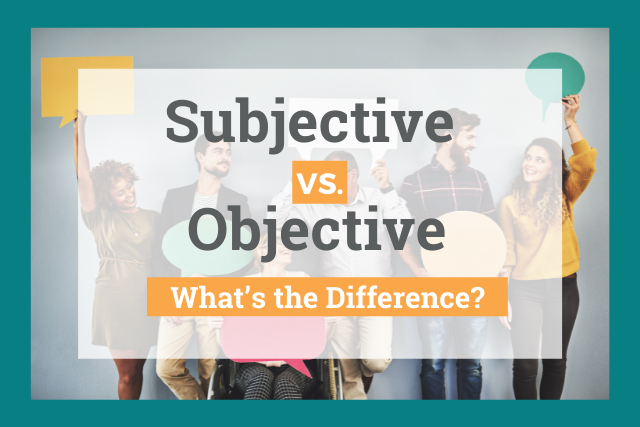
If you’re trying to write a strong essay or story, it’s often important to understand the difference between subjective and objective truth.
What exactly do the words subjective and objective mean, and when should you use each?
This article will explain the difference between the two words, provide examples of how they’re used in a sentence, and discuss whether you should look for objective or subjective information to support your own writing.
- What’s the Difference Between Subjective vs. Objective?
How Would You Use Objective and Subjective in a Sentence?
What are some examples of objective statements, what are some examples of subjective information, how can you tell if something is objective or subjective, what is an objective opinion, are impartial facts better than personal feelings, what’s the difference between subjective vs. objective .
The difference between objective and subjective is related to the difference between facts and opinions.
The word objective describes information that’s based on verifiable facts. Objective truth can be verified by a third party, regardless of who the third party is.
For example, the sentence “The temperature outside is around 10°C” is an objective statement, because that statement will be equally true no matter who says it. Anybody in the world with a working thermometer could verify this statement.
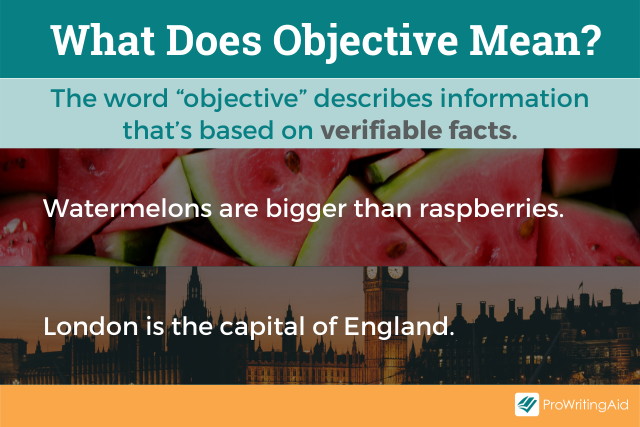
The word subjective is the exact opposite; it describes information that’s based on personal opinion or personal interpretation.
Subjective truth might be different for different people, depending on their own tastes, preferences, or experiences.
The sentence “It’s very cold outside” is a subjective statement, because how true this sentence is depends on personal opinions and experiences.
Many temperatures would feel very cold to someone who grew up in Arizona, but comfortably warm to someone who grew up in Alaska.
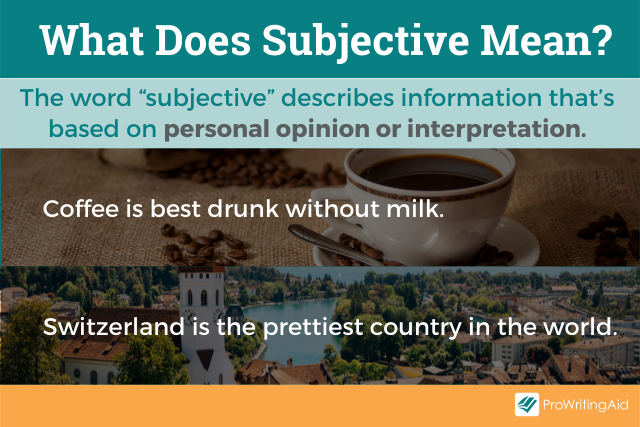
One easy way to remember the difference between the two words is to remember that “objective” sounds like “object.”
Objective facts are as concrete as the objects you can touch, like your desk, your bike, or your water bottle.
Subjective facts, on the other hand, pertain to more abstract concepts, like beauty, joy, or discomfort.
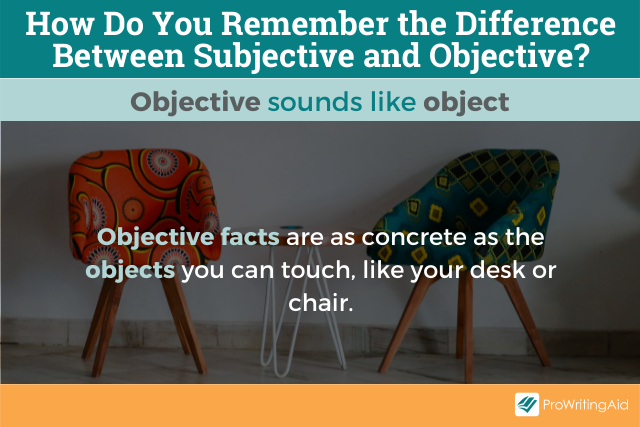
Here’s an example of a sentence that uses both objective and subjective in context:
"But now we, as pathologists, need more objective measures because symptoms, to a certain degree, are subjective ." (Time)
This sentence, a quote from a pathologist, argues that symptoms of diseases are somewhat subjective because they differ from person to person.
One patient with the flu might feel horribly nauseous, while another patient with the same flu might feel only a mild cough.
As a result, it’s useful for doctors to have objective tools to determine how ill people are, which don’t have results that vary from person to person.
That way, they can track the way a disease spreads even if not all patients feel the same symptoms.
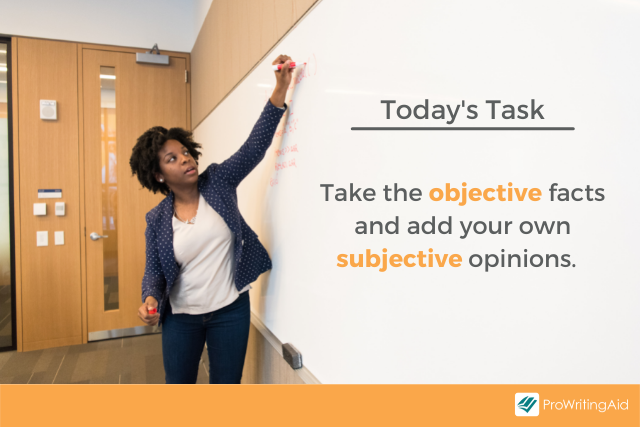
Let’s look at another example.
"We take our unruly, subjective feelings about a year of television and groom them into something that looks mathematical and objective ." (Slate)
This sentence, a quote from a TV critic, argues that trying to rank TV shows is a meaningless task.
Every viewer has different tastes; some might love lighthearted sitcoms, while others prefer serious dramas.
There’s no objective way for a TV critic to determine a Top 10 list that applies to everybody, because everyone’s tastes and enjoyment levels are inherently subjective.
If what you’re writing can be proven or disproven by evidence, it’s an objective statement. Likewise, if you include a reference to an study or an experiment, it is an objective statement.
Remember to always reference information like this. ProWritingAid’s Plagiarism Checker can ensure that you never inadvertently pass off someone else’s work as your own.
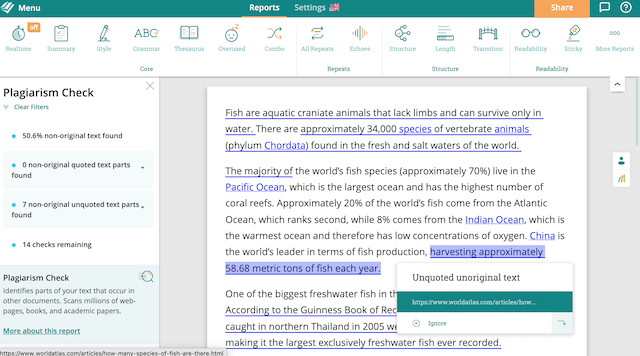
Find out more about Plagiarism Checks.
Here are some examples of objective information:
- The largest freshwater fish ever caught was 646 pounds. (Cite- Brittanica)
- Abraham Lincoln was the sixteenth president of the United States.
- The World Health Organization declared COVID-19 a pandemic on March 11, 2020.
- I have eaten the plums that were in the icebox.
Keep in mind that those statements would still be considered objective even if they were false.
It’s a common mistake to assume that “objective” is synonymous with “true,” but lies can be objective statements, too. The statement remains objective as long as it doesn’t depend on feelings or opinions.
For example, if William Carlos Williams had written “I didn’t eat any of the plums that were in the icebox,” even though he actually did, that would still qualify as an objective statement.
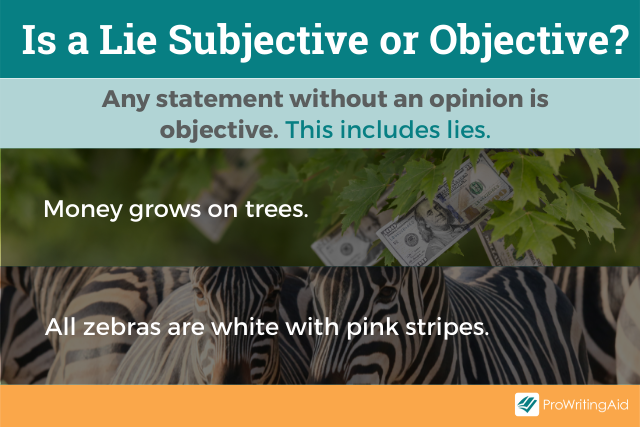
Here are some examples of false objective statements:
- Abraham Lincoln was the first president of the United States.
- The World Health Organization has never issued an official statement about COVID-19.
- I didn’t eat any of the plums that were in the icebox.
If a statement relies on personal feelings or beliefs, it’s likely to be subjective.
Here are some examples of subjective statements:
- It feels very warm outside.
- Dogs are better than cats.
- The plums in the icebox tasted delicious.
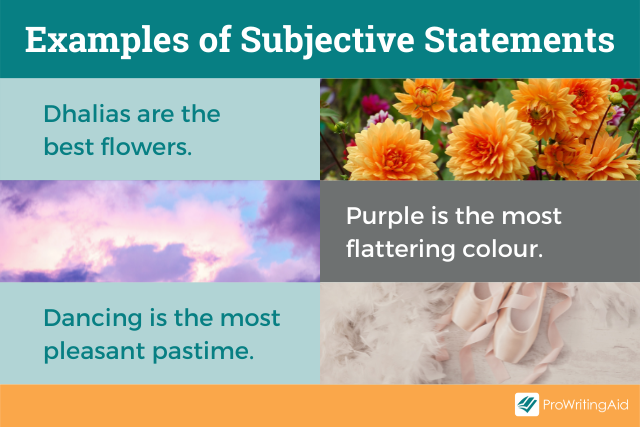
Watch out for subjective information that’s disguised as objective analysis. For example, a newspaper headline that says “New Study Shows That Dogs Are 85% Better Than Cats” sounds like an objective fact. However, because it depends on personal preferences and opinions, it’s still a subjective statement.
Here are some subjective statements that are disguised to sound like objective statements:
- It is objectively very warm outside.
- A new study shows that dogs are 85% better than cats.
- Plums in iceboxes taste ten times better than plums that are left in the heat.
If you’re not sure whether a statement is objective or subjective, here are some useful questions you can ask yourself.
To determine whether a statement is objective , ask:
- Is this statement based on factual evidence?
- Is there a way a scientist could test this statement to figure out if it’s true or false?
- Would a robot without any concept of human emotion be able to say this statement?
If the answers to any of the above questions are “yes,” you’re probably dealing with an objective statement.
To determine whether a statement is subjective , ask:
- Is this statement based on someone’s feelings, preferences, or personal tastes?
- Is it impossible to determine whether this statement is true or false?
- Does this statement make a judgement about something (e.g. good or bad, right or wrong, beautiful or ugly)?
If the answers to any of the above questions are “yes,” you’re probably dealing with a subjective statement.
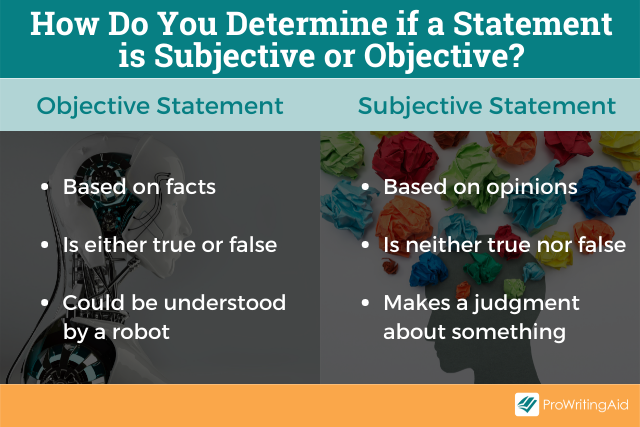
You can also look at the source of the statement to help you figure out how objective it is.
Sources like peer-reviewed scientific articles and unbiased news articles tend to contain more objective material.
Sources like opinion pieces and creative non-fiction tend to contain more subjective material.
The phrase "objective opinion" might seem counterintuitive, since these two words are essentially opposites.
In this context, the word "objective" means unbiased and impartial, rather than factual. This is also true for the phrase "objective assessment."
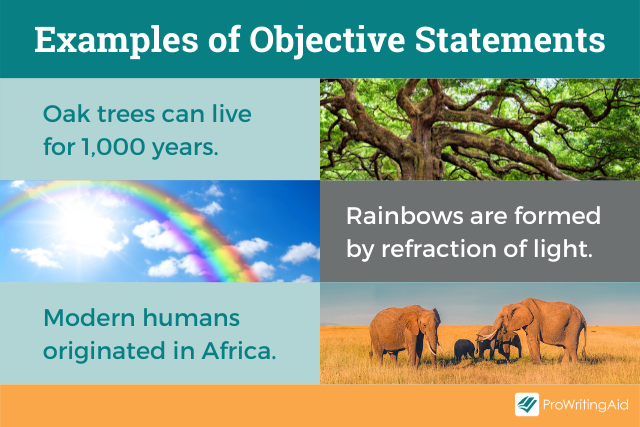
For example, you might ask a friend for an objective opinion about whether or not you should break up with your boyfriend.
In this scenario, your friend can’t give you objective advice if they have a personal reason for wanting you to make this decision, such as if they’re secretly in love with your boyfriend too.
Whether you should use subjective or objective statements depends on what your goal is.
If you’re writing a persuasive essay, you’ll usually need factual or quantitative data to make your writing credible. It’s important to search for objective facts from a reliable and impartial source.
On the other hand, you can also make use of subjective evidence, such as personal anecdotes. If you’re writing a persuasive essay about why bullying is wrong, a heartfelt story from the perspective of someone who’s been bullied might touch more readers than impersonal facts.
Most strong essays make use of both subjective and objective truth.
Final Words on the Difference Between Subjective vs. Objective
There you have it: a comprehensive guide to the difference between subjective and objective statements. Which examples did you find most helpful? Let us know in the comments.
Now is a wonderful time to be a copywriter. Download this free book to learn how:
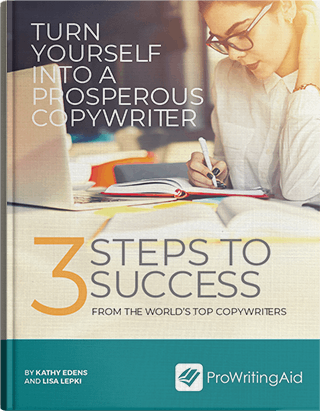
Turn Yourself Into a Prosperous Copywriter
With the advent of the internet, the copywriting industry is exploding. content is now seen as critical for all online businesses., this guide breaks down the three essential steps you must take if you think copywriting is the career for you..

Be confident about grammar
Check every email, essay, or story for grammar mistakes. Fix them before you press send.
Hannah Yang is a speculative fiction writer who writes about all things strange and surreal. Her work has appeared in Analog Science Fiction, Apex Magazine, The Dark, and elsewhere, and two of her stories have been finalists for the Locus Award. Her favorite hobbies include watercolor painting, playing guitar, and rock climbing. You can follow her work on hannahyang.com, or subscribe to her newsletter for publication updates.
Get started with ProWritingAid
Drop us a line or let's stay in touch via :
- I nfographics
- Show AWL words
- Subscribe to newsletter
- What is academic writing?
- Academic Style
- What is the writing process?
- Understanding the title
- Brainstorming
- Researching
- First draft
- Proofreading
- Report writing
- Compare & contrast
- Cause & effect
- Problem-solution
- Classification
- Essay structure
- Introduction
- Literature review
- Book review
- Research proposal
- Thesis/dissertation
- What is cohesion?
- Cohesion vs coherence
- Transition signals
- What are references?
- In-text citations
- Reference sections
- Reporting verbs
- Band descriptors
Show AWL words on this page.
Levels 1-5: grey Levels 6-10: orange
Show sorted lists of these words.
| --> |
Any words you don't know? Look them up in the website's built-in dictionary .
|
|
Choose a dictionary . Wordnet OPTED both
Writing objectively How and when to use an impersonal tone
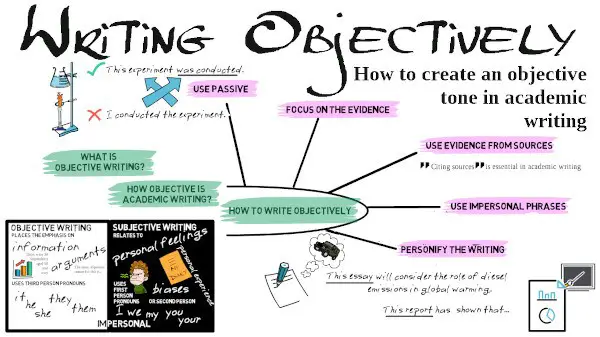
For another look at the same content, check out the video on YouTube (also available on Youku ). There is a worksheet (with answers and teacher's notes) for this video.
Academic writing is generally impersonal and objective in tone. This section considers what objective writing is , how objective academic writing is , then presents several ways to make your writing more objective . There is also an academic article , to show authentic examples of objective language, and a checklist at the end, that you can use to check the objectivity of your own writing.
What is objective writing?
Objective writing places the emphasis on facts, information and arguments, and can be contrasted with subjective writing which relates to personal feelings and biases. Objective writing uses third person pronouns (it, he, she, they), in contrast to subjective writing which uses first person pronouns (I, we) or second person pronoun (you).
How objective is academic writing?
Although many academic writers believe that objectivity is an essential feature of academic writing, conventions are changing and how much this is true depends on the subject of study. An objective, impersonal tone remains essential in the natural sciences (chemistry, biology, physics), which deal with quantitative (i.e. numerical) methods and data. In such subjects, the research is written from the perspective of an impartial observer, who has no emotional connection to the research. Use of a more subjective tone is increasingly acceptable in areas such as naturalist research, business, management, literary studies, theology and philosophical writing, which tend to make greater use of qualitative rather than quantitative data. Reflective writing is increasingly used on university courses and is highly subjective in nature.
How to write objectively
There are many aspects of writing which contribute to an objective tone. The following are some of the main ones.
Use passive
Objective tone is most often connected with the use of passive, which removes the actor from the sentence. For example:
- The experiment was conducted.
- I conducted the experiment.
- The length of the string was measured using a ruler.
- I measured the length of the string with a ruler.
Most academic writers agree that passive should not be overused, and it is generally preferrable for writing to use the active instead, though this is not always possible if the tone is to remain impersonal without use of I or other pronouns. There is, however, a special group of verbs in English called ergative verbs , which are used in the active voice without the actor of the sentence. Examples are dissolve, increase, decrease, lower, and start . For example:
- The white powder dissolved in the liquid.
- I dissolved the white powder in the liquid.
- The white powder was dissolved in the liquid.
- The tax rate increased in 2010.
- We increased the tax rate in 2010.
- The tax rate was increased in 2010.
- The building work started six months ago.
- The workers started the building work six months ago.
- The building work was started six months ago.
Focus on the evidence
Another way to use active voice while remaining objective is to focus on the evidence, and make this the subject of the sentence. For example:
- The findings show...
- The data illustrate...
- The graph displays...
- The literature indicates...
Use evidence from sources
Evidence from sources is a common feature of objective academic writing. This generally uses the third person active. For example:
- Newbold (2021) shows that... He further demonstrates the relationship between...
- Greene and Atwood (2013) suggest that...
Use impersonal constructions
Impersonal constructions with It and There are common ways to write objectively. These structures are often used with hedges (to soften the information) and boosters (to strengthen it) . This kind of language allows the writer to show how strongly they feel about the information, without using emotive language, which should be avoided in academic writing.
- It is clear that... (booster)
- It appears that... (hedge)
- I believe that...
- There are three reasons for this.
- I have identified three reasons for this.
- There are several disadvantages of this approach.
- This is a terrible idea.
Personify the writing
Another way to write objectively is to personify the writing (essay, report, etc.) and make this the subject of the sentence.
- This essay considers the role of diesel emissions in global warming.
- I will discuss the role of diesel emissions in global warming.
- This report has shown that...
- I have shown that...
In short, objective writing means focusing on the information and evidence. While it remains a common feature of academic writing, especially in natural sciences, a subjective tone is increasingly acceptable in fields which make use of qualitative data, as well as in reflective writing. Objectivity in writing can be achieved by:
- using passive;
- focusing on the evidence ( The findings show... );
- referring to sources ( Newbold (2021) shows... );
- using impersonal constructions with It and There ;
- using hedges and boosters to show strength of feeling, rather than emotive language;
- personifying the writing ( This report shows... ).
Bailey, S. (2000). Academic Writing. Abingdon: RoutledgeFalmer
Bennett, K. (2009) 'English academic style manuals: A survey', Journal of English for Academic Purposes , 8 (2009) 43-54.
Cottrell, S. (2013). The Study Skills Handbook (4th ed.) , Basingstoke: Palgrave MacMillan.
Hinkel, E. (2004). Teaching Academic ESL Writing: Practical Techniques in Vocabulary and Grammar . Mahwah: Lawrence Erlbaum Associates Inc Publishers.
Hyland, K. (2006) English for Academic Purposes: An advanced resource book . Abingdon: Routledge.
Jordan, R. R. (1997) English for academic purposes: A guide and resource book for teachers . Cambridge: Cambridge University Press.
Example article
Below is an authentic academic article. It has been abbreviated by using the abstract and extracts from the article; however, the language is unchanged from the original. Click on the different areas (in the shaded boxes) to highlight the different objective features.
Title: Obesity bias and stigma, attitudes and beliefs among entry-level physiotherapy students in the Republic of Ireland: a cross sectional study. Source: : https://www.sciencedirect.com/science/article/pii/S0031940621000353

| [1] | Nat Rev Endocrinol, 16 (5) (2020), p. 253 |
| [2] | F. Rubino, R.M. Puhl, D.E. Cummings, R.H. Eckel, D.H. Ryan, J.I. Mechanick, et al. Nat Med, 26 (4) (2020), pp. 485-497 |
| [3] | J. Seymour, Jl Barnes, J. Schumacher, Rl. Vollmer Inquiry, 55 (2018), Article 46958018774171 |
| [4] | S.M. Phelan, D.J. Burgess, M.W. Yeazel, W.L. Hellerstedt, J.M. Griffin, M. van Ryn Obes Rev, 16 (4) (2015), pp. 319-32 |
| [5] | J.A.M.M. Sabin, B.A. Nosek PLoS One, 7 (2012), Article e48448 |

GET FREE EBOOK
Like the website? Try the books. Enter your email to receive a free sample from Academic Writing Genres .
Below is a checklist for using objectivity in academic writing. Use it to check your writing, or as a peer to help. Note: you do not need to use all the ways given here.
| The writing is . | ||
| The writing uses to avoid personal pronouns (e.g. ). Passive is not overused. | ||
| The writing (e.g. ). | ||
| The writing uses and third person pronouns (e.g. ). | ||
| The writing uses with and . | ||
| The writing uses (e.g. |
Next section
Read more about writing critically in the next section.
- Critical writing
Previous section
Go back to the previous section about using complex grammar .
- Complex grammar

Author: Sheldon Smith ‖ Last modified: 05 February 2024.
Sheldon Smith is the founder and editor of EAPFoundation.com. He has been teaching English for Academic Purposes since 2004. Find out more about him in the about section and connect with him on Twitter , Facebook and LinkedIn .
Compare & contrast essays examine the similarities of two or more objects, and the differences.
Cause & effect essays consider the reasons (or causes) for something, then discuss the results (or effects).
Discussion essays require you to examine both sides of a situation and to conclude by saying which side you favour.
Problem-solution essays are a sub-type of SPSE essays (Situation, Problem, Solution, Evaluation).
Transition signals are useful in achieving good cohesion and coherence in your writing.
Reporting verbs are used to link your in-text citations to the information cited.
Skip to Content
Massey University
- Search OWLL
- Handouts (Printable)
- Pre-reading Service
- StudyUp Recordings
- StudyUp Postgraduate
- Academic writing
- Intro to academic writing
- What is academic writing?
Writing objectively
- Writing concisely
- 1st vs. 3rd person
- Inclusive language
- Te Reo Māori
- Assignment planning
- Assignment planning calculator
- Interpreting the assignment question
- Command words
- Organising points
- Researching
- Identifying academic sources
- Evaluating source quality
- Editing & proofreading
- Apostrophes
- Other punctuation
- Active voice
- American vs. British spelling
- Conditionals
- Prepositions
- Pronoun Reference
- Sentence fragments
- Sentence Structure
- Subject-verb agreement
- Formatting and layout
- Word limits and assignment length
- Commonly confused words
- How assignments are marked
- Marking guides
- Getting an A
- Levels of assessment
- Using feedback
- Professional emails
- Forum posts
- Forum netiquette guidelines
- Sharing personal information
- Writing about personal experiences
- Assignment types
- What is an essay?
- Essay planning and structure
- Introduction
- Thesis statement
- Body paragraphs
- Essay revision
- Essay writing resources
- What is a report?
- Report structure
- Analysing issues for a report
- Business report
- What is a business report?
- Business report structure
- Inductive vs. deductive reports
- Other kinds of business communication
- Business report format and layout
- What is a lab report?
- Lab report structure
- Science lab report writing resources
- Psychology lab report writing resources
- Lab report body paragraphs
- Literature review
- What is a literature review?
- Writing a literature review
- Literature review structure
- Literature review writing resources
- Research proposal
- Writing a research proposal
- Research proposal structure
- Other types
- Article critique
- Book review
- Annotated bibliography
- Reflective writing
- Oral presentation
- Thesis / dissertation
- Article / conference paper
- Shorter responses
- PhD confirmation report
- Computer skills
- Microsoft Word
- Basic formatting
- Images, tables, & figures
- Long documents
- Microsoft Excel
- Basic spreadsheets
- Navigating & printing spreadsheets
- Charts / graphs & formulas
- Microsoft PowerPoint
- Basic skills
- Advanced skills
- Distance study
- Getting started
- How to study
- Online study techniques
- Distance support
- Reading & writing
- Reading strategies
- Writing strategies
- Grammar resources
- Listening & speaking
- Listening strategies
- Speaking strategies
- Maths & statistics
- Trigonometry
- Finance formulas
- Postgraduate study
- Intro to postgrad study
- Planning postgrad study
- Postgrad resources
- Postgrad assignment types
- Referencing
- Intro to referencing
- What is referencing?
- Why reference?
- Common knowledge
- Referencing styles
- What type of source is this?
- Reference list vs. bibliography
- Referencing software
- Quoting & paraphrasing
- Paraphrasing & summarising
- Paraphrasing techniques
- APA Interactive
- In-text citation
- Reference list
- Online material
- Other material
- Headings in APA
- Tables and Figures
- Referencing elements
- 5th vs. 6th edition
- 6th vs. 7th edition
- Chicago style
- Chicago Interactive
- About notes system
- Notes referencing elements
- Quoting and paraphrasing
- Author-date system
- MLA Interactive
- Abbreviations
- List of works cited
- Captions for images
- 8th vs 9th edition
- Oxford style
- Other styles
- Harvard style
- Vancouver style
- Legal citations
- Visual material
- Sample assignments
- Sample essay 1
- Sample essay 2
- Sample annotated bibliography
- Sample book review
- Study skills
- Time management
- Intro to time management
- Procrastination & perfectionism
- Goals & motivation
- Time management for internal students
- Time management for distance students
- Memory skills
- Principles of good memory
- Memory strategies
- Note-taking
- Note-taking methods
- Note-taking in lectures
- Note-taking while reading
- Digital note-taking
- Reading styles
- In-depth reading
- Reading comprehension
- Reading academic material
- Reading a journal article
- Reading an academic book
- Critical thinking
- What is critical thinking?
- Constructing an argument
- Critical reading
- Logical fallacies
- Tests & exams
- Exam & test study
- Planning exam study
- Gathering & sorting information
- Reviewing past exams
- Phases of revision
- Last-minute study strategies
- Question types
- Short answer
- Multi-choice
- Problem / computational
- Case-study / scenario
- Open book exam
- Open web exam or test
- Take home test
- In the exam
- Online exam
- Physical exam
Being objective suggests that you are concerned about facts and are not influenced by personal feelings or biases. Part of being objective is being fair in your work. Try to consider both sides of an argument and avoid making value judgements by using words such as wonderful or appalling. Being objective also makes your work more professional and credible.
Techniques for making your writing more objective
Be explicit in expressing your ideas:.
- several ⇒ 10
- most of the population ⇒ 70%
- some time ago ⇒ three years ago; or in 2006
Avoid intensifiers which can tend to exaggerate your writing in an imprecise, subjective way:
- For example, awfully, very, really.
Part of being objective is being balanced in your work, professional and believable:
- Try to avoid making value judgements through use of words such as amazing or dreadful.
First vs. third person
Pronouns are a set of words that replace nouns. They can be used to make your work less complicated and less repetitive. Examples of pronouns include:
- First person: I, we, me, us
- Second person: you
- Third person: he, she, it, they, him, her, them
For some assignments, it is appropriate to use the first person (e.g. reflective writing). However, for other assignments the third person is preferred. Sometimes a mixture of the first and third person should be used for different purposes. So, check your assignment guidelines for each assignment, as it will differ for different assignment types , different style guides, and different disciplines. If you are unsure, then check with your course coordinator. For more on this see 1st person vs. 3rd person .
Page authorised by Director - Centre for Learner Success Last updated on 29 November, 2018
- Academic Q+A
Have a study or assignment writing question? Ask an expert at Academic Q+A
Live online workshops
- StudyUp (undergraduate)
- Campus workshops
- Albany (undergraduate)
- Albany (postgraduate)
- Albany (distance)
- Manawatu (undergraduate)
- Manawatu (postgraduate)
Upcoming events
- All upcoming events
- Academic writing and learning support
- 0800 MASSEY | (+64 6 350 5701)
- [email protected]
- Online form
Objective Writing
- Icon Calendar 17 May 2024
- Icon Page 553 words
- Icon Clock 3 min read
The purpose of higher learning is to communicate ideas effectively through writing. Basically, teachers expect learners to present accurate findings, concerning a specific matter. In this case, students use verifiable evidence. Also, the method is unique because it allows one to gather, calculate, or evaluate information. In turn, objective writing enables people to present irrefutable facts, apply critical thinking styles, maintain a neutral tone, and use formal and explicit language.
Presenting Facts
Objective writing is a factual process that enhances knowledge. For instance, learners gather facts that support the selected topic. In this case, one must support arguments with evidence from credible sources. Besides, students address both sides of an opinion. Then, being objective makes essays appear professional and reliable. In turn, people avoid making judgments. Also, they remain fair in their work. Thus, empirical writing allows individuals to present accurate information that addresses existing knowledge gaps.
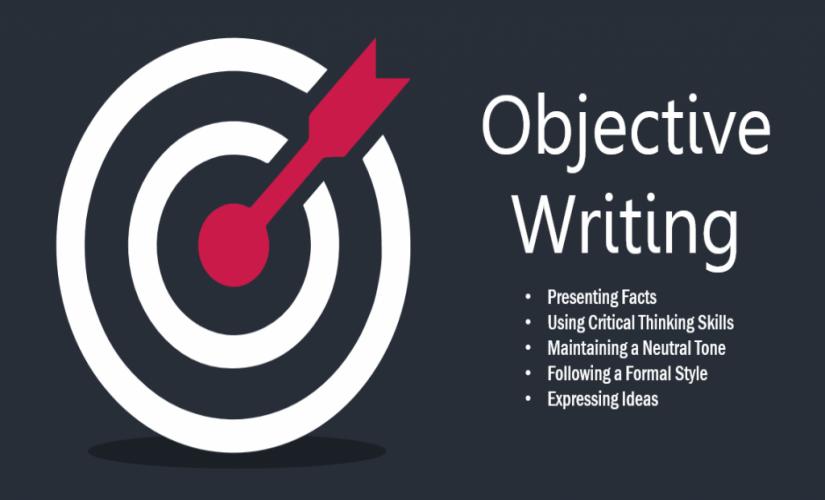
Critical Thinking in Objective Writing
Objective writing is unique because it enhances critical thinking. For instance, learners evaluate, calculate, and verify the information. In this case, students must gather relevant details and determine their significance to the subject. Besides, people must ensure that the audience attains a deeper understanding of the topic. Therefore, learners must appraise information to achieve the desired goals during factual writing.
Maintaining a Neutral Tone
Objective writing is essential because it allows students to use a neutral tone. For instance, one should not use opinionated, biased, or exclusive language. Basically, learners must submit unbiased information to an audience. Instead, scholars allow readers to determine their opinions. However, imbalanced information does not persuade people to accept a narrow way of thinking. In this case, the approach helps writers to present relevant facts about a subject. Thus, scholars should learn factual writing since the method allows them to be less judgmental.
Following a Formal Style in Objective Writing
Objective writing is an essential skill because it helps learners to follow formal style. Basically, academic papers must use the official language. In this case, students avoid personal pronouns. Also, the extensive use of the third person enhances the clarity of an assignment. Then, empirical writing helps scholars to avoid intensifiers that exaggerate their arguments. For example, people should avoid words, like “very” and “really,” since they make information vague. Finally, scholarly papers require the proper use of punctuation marks. In turn, successful learners proofread their works to ensure that they use commas and full stops effectively. Besides, the approach prevents all forms of miscommunication. Therefore, writers should follow the rules of factual writing because it trains them to maintain a formal tone in their papers.
Expressing Ideas
Objective writing allows students to express ideas explicitly. For example, learners develop precise sentences to express their thoughts. In this case, they make their work comprehensible. Besides, the approach helps essays to stand out. Therefore, people should learn objective writing because it allows them to communicate clearly.
Summing Up on Objective Writing
In conclusion, objective writing requires people to cover irrefutable facts. Basically, the process is unique because it enables learners to develop critical thinking skills when completing assignments. Also, scholars should learn to empirical writing because they gain the ability to follow a neutral tone. In turn, they learn to write by using a formal and specific style. Thus, objective writing improves the quality of academic papers.
To Learn More, Read Relevant Articles

Essay on Education
- Icon Calendar 5 December 2019
- Icon Page 708 words
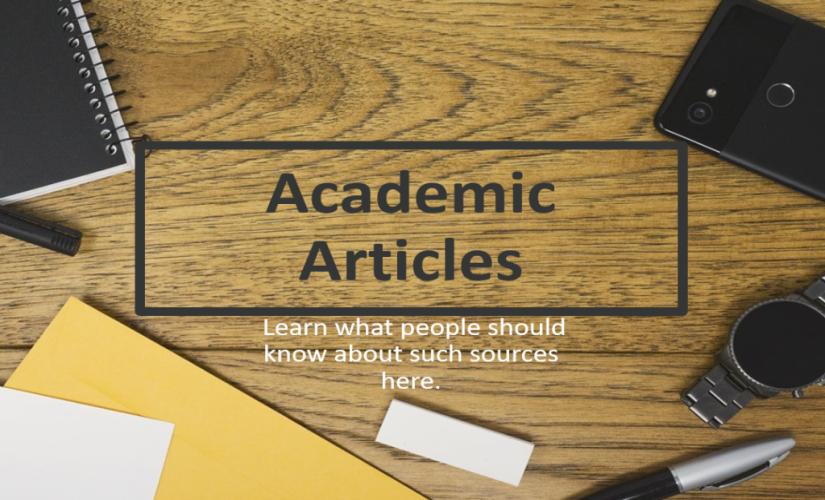
Academic Articles
- Icon Calendar 26 November 2019
- Icon Page 560 words
- How to Cite
- Language & Lit
- Rhyme & Rhythm
- The Rewrite
- Search Glass
Objectives for Writing an Essay
An essay does more than inform or persuade a reader. The process of writing an essay teaches a student how to research a topic and organize her thoughts into an introduction, a body and a conclusion. Essay writing objectives apply to expository and persuasive essays on a variety of topics.
Thesis Development
Every essay should clearly state a thesis -- the main idea of the essay. A mere overview of a topic that does not take a stand one way or the other is not a thesis. The main idea of the essay should be obvious to the reader.
Organizational Patterns
The student's essay should be well organized and should not stray from his main topic. The essay should start by introducing the reader to the main points that the writer will cover in the essay. It should use transitions from general to specific to present the information. The essay should end with a conclusion that sums up the main points and restates the thesis.
Content Details
The student should provide detailed information about her thesis, supported by reputable, authoritative research references. The student should make her strongest points first, including just one main point in each paragraph. She should anticipate and rebut her opponent's arguments against the thesis and discuss plausible alternatives to the thesis.
Style Points
The student should use a consistent, academic voice. His essay should conform to assigned style guidelines and should be free of misspellings and grammatical errors. The writer should cite all references in proper format, and each reference must support the material for which he cited it.
Marilyn Lindblad practices law on the west coast of the United States. She has been a freelance writer since 2007. Her work has appeared on various websites. Lindblad received her Juris Doctor from Lewis and Clark Law School.
Subjective vs. Objective
Subjective information or writing is based on personal opinions, interpretations, points of view, emotions and judgment. It is often considered ill-suited for scenarios like news reporting or decision making in business or politics. Objective information or analysis is fact-based, measurable and observable.
Comparison chart
| Objective | Subjective | |
|---|---|---|
| Based upon | Observation of measurable facts | Personal opinions, assumptions, interpretations and beliefs |
| Commonly found in | Encyclopedias, textbooks, news reporting | Newspaper editorials, blogs, biographies, comments on the Internet |
| Suitable for decision making? | Yes (usually) | No (usually) |
| Suitable for news reporting? | Yes | No |
Examples of Objective and Subjective Writing
Here are some examples of objective and subjective statements:
- "47% of Americans pay no federal income tax. These people believe they are victims and would never vote for a Republican candidate." In this quote (which paraphrases Mitt Romney ), the first statement is objective. It is a measurable fact that 47% of Americans do not pay federal income taxes . However, the second statement is Romney's personal point of view and is entirely subjective.
- Apple only allows apps that the company has approved to be installed on iOS devices. The company does not care about openness of their platform. Once again the first statement here is objective, while the second is subjective because fans of the company could argue, as Steve Jobs did , that iOS is indeed an "open" platform.
Objective vs. Subjective Reality
A popular thought experiment asks this hypothetical question: if a tree falls in a forest and there is no one to hear it, does it make a sound? The objective reality in this scenario is that the tree did fall in the forest and made a sound. The objective view is not dependent upon there being an observer for the event. However, there is a school of thought in philosophy that believes that our perception of reality is governed by our senses, which are limited and flawed. Therefore, there is no objective reality that we can discern, and all reality is subjective. Reality is a social construct , a common denominator of the subjective experiences and perceptions of society forms our reality.
Related Comparisons

Share this comparison via:
If you read this far, you should follow us:
"Subjective vs Objective." Diffen.com. Diffen LLC, n.d. Web. 22 Jun 2024. < >
Comments: Objective vs Subjective
- Deductive vs Inductive
- Data vs Information
- Theory vs Hypothesis
- Knowledge vs Wisdom
- Advice vs Advise
- Chance vs Risk
Edit or create new comparisons in your area of expertise.
Stay connected
© All rights reserved.

Objective vs. Subjective – What’s the Difference?
Home » Objective vs. Subjective – What’s the Difference?
In today’s climate of widespread, often heated disagreement, the ability to successfully distinguish facts from opinions is more important than ever. Effective arguments include both factual observations and value judgements based on those facts.
In this way, arguments contain both objective and subjective statements. But which is which?
It is important to note that both objective and subjective have multiple senses. In this article, I will focus on their use as they relate to the concepts of objectivity and subjectivity in the philosophy of knowledge, or in simpler terms, to facts and opinions.
Since this site is devoted to writing and language use, I would be remiss not to include a discussion on objective and subjective as grammatical senses, as well.
What is the Difference Between Objective and Subjective?
In this article, I will compare objective vs. subjective . I will use each word in an example sentence to illustrate its proper context.
Plus, I will give you a useful memory tool that will help you decide whether something is objective or subjective .
When to Use Objective

Here are some example sentences,
- The journalist strived to engage in objective reporting.
- “Before we can proceed, we need an objective assessment of the facts of the case,” said the detective.
- “I want an objective analysis of our cash flow problems on my desk by Monday morning,” said the board chair.
- In other words, the model is purely objective and ignores outside factors like personnel, coaching and motivation. – The Wall Street Journal
In grammar, objective means referring to nouns or pronouns used as the object in a sentence . Also, see article on objective pronouns .
When to Use Subjective

For example,
- “My subjective stance,” wrote the columnist, “is that the pasta was not very delicious.”
- Journalists should not allow subjective views to contaminate hard news reporting.
- “The article suffers from subjective interpretations of data, and we reject it from publication in this journal,” wrote a peer reviewer.
- Measuring corruption is difficult and subjective, but in 2015 the group compiled a Corruption Perceptions Index that ranks 168 countries based on the perception of corruption in the public sector. – The New York Times
With regard to sentence-level grammar, subjective refers to nouns or pronouns used as the subject of a sentence. Also, see article on subjective pronouns .
Trick to Remember the Difference

Here is a helpful trick to remember subjective vs. objective . Since objective and observation both begin with the letter O , you can use this letter to link the words together in your mind.
Also, subjective and feelings both contain the letter S , which you can use as an additional mnemonic.
Is it objective or subjective? Objective and subjective are adjectives that refer to unbiased observations and biased evaluations , respectively. They each also have a grammatical sense, where they refer to the function and placement of nouns and pronouns in sentences.
- Something that is objective is not influenced by feelings or personal biases.
- Something that is subjective is up for personal interpretation and subject to personal feelings.
Since both subjective and feelings contain the letter S , you can use this shared feature as a mnemonic to help you remember which word is which.
If you still need help, remember to check this site for a quick refresher, as well as any time you need help with a difficult writing topic.
- Link to facebook
- Link to linkedin
- Link to twitter
- Link to youtube
- Writing Tips
6 Tips on Achieving an Objective Tone in Writing

- 5-minute read
- 11th July 2021
An objective tone is standard in most formal business and academic writing. But how can you make your writing sound objective? Our top tips include:
- Try to avoid unnecessary use of the first person and first-person pronouns.
- Focus on facts and cite sources clearly to back up your claims.
- Aim for balance and consider multiple perspectives.
- Beware of emotive language that betrays a subjective opinion.
- Use a formal writing style throughout.
- Have your writing proofread to make sure it is always error-free.
For more detail on how to achieve an objective tone in writing, read on.
1. Try Not to Use the First Person
Objective writing aims for a neutral, impersonal tone. As such, you should try to minimise the use of the first person and first-person pronouns such as ‘I’, ‘me’ and ‘mine’, which put too much focus on you as the writer of the document.
One option is to use the passive voice more. For instance:
I will outline the main arguments. -> The main arguments will be outlined.
However, this can sound awkward or leave your writing unclear (e.g. the sentence above does not specify who or what will outline the arguments). As such, it is often better to stick to the active voice and use the third person instead. For example:
This paper will outline the main arguments.
Here, the meaning is clear, but we avoid using any first-person pronouns.
2. Focus on Facts and Data
Objective writing should be clear and factual. As such, you will need to:
- Research your topic extensively – Before you start writing, make sure to research the topic in detail so you are clear on the facts.
- Always cite your sources – Citing sources adds credibility to your writing by showing your reader where your information came from.
- Consider your sources – Where you get information from matters. Your sources should be unbiased, especially in academic writing. Before citing something or quoting a fact, then, make sure it is from a trustworthy source .
If you can back up your claims with well-researched facts, your writing will come across as much more objective than if you simply make unsupported claims.
3. Be Fair and Balanced
If you present only one side of an argument in your writing, it could appear biased and lose credibility. To achieve an objective tone, then, you must show balance. And this means sharing different viewpoints and perspectives.
Find this useful?
Subscribe to our newsletter and get writing tips from our editors straight to your inbox.
This is especially important if you are presenting an argument in academic writing where acknowledging potential counterarguments or competing points of view is a key part of testing the strength of your position. But it also applies to business writing, where considering multiple perspectives provides important context and shows that you have researched the issue thoroughly.
You don’t always have to give every opinion equal weight or present every possible argument, though, or you run the risk of overwhelming the reader with too much information. Instead, focus on the key perspectives in the subject area.
4. Avoid Emotive Language
Typically, objective writing should avoid emotive language or words that suggest a subjective opinion. For example:
Smith (2020) offers a brilliantly clever solution to this terrible problem.
Here, the words ‘brilliantly clever’ and ‘terrible’ don’t add anything substantive to the sentence. Rather, they signal something about the author’s opinion. And by adding this kind of emotive language, we prompt the reader to respond in a particular way (e.g. to see the solution as ‘brilliantly clever’).
This is not to say you should never offer an opinion in objective writing (e.g. you may need to weigh the benefits of certain actions and recommend the best option to meet a specific objective, which will inevitably involve an element of opinion). But you should present your opinions in a neutral tone and back them up with facts, not relying on emotive or otherwise subjective language to influence your reader.

5. Keep Your Writing Formal
As well as the subjective and emotive language discussed so far, objective writing should avoid informal and colloquial language. This includes:
- Using standard spelling and grammar throughout.
- Avoiding contractions (e.g. instead of using ‘can’t’, use ‘cannot’).
- Cutting out all slang and informal figures of speech.
- Using the correct technical language for your subject area.
This formal style is common in business and academic writing as it reduces the strength of the individual’s voice and thus contributes to an objective tone.
6. Have Your Work Proofread
Errors in writing suggest a lack of care or attention to detail (even when this isn’t true). To make sure your documents have a truly objective, authoritative tone, then, it pays to get them proofread by the writing experts.
Our editors are available 24/7, all year round, so we are always here to help. You can even try our services for free ! Get in touch today to find out more.
Share this article:
Post A New Comment
Get help from a language expert. Try our proofreading services for free.
9-minute read
How to Use Infographics to Boost Your Presentation
Is your content getting noticed? Capturing and maintaining an audience’s attention is a challenge when...
8-minute read
Why Interactive PDFs Are Better for Engagement
Are you looking to enhance engagement and captivate your audience through your professional documents? Interactive...
7-minute read
Seven Key Strategies for Voice Search Optimization
Voice search optimization is rapidly shaping the digital landscape, requiring content professionals to adapt their...
How to Ace Slack Messaging for Contractors and Freelancers
Effective professional communication is an important skill for contractors and freelancers navigating remote work environments....
3-minute read
How to Insert a Text Box in a Google Doc
Google Docs is a powerful collaborative tool, and mastering its features can significantly enhance your...
2-minute read
How to Cite the CDC in APA
If you’re writing about health issues, you might need to reference the Centers for Disease...

Make sure your writing is the best it can be with our expert English proofreading and editing.
Have a language expert improve your writing
Run a free plagiarism check in 10 minutes, generate accurate citations for free.
- Knowledge Base
- How to write an argumentative essay | Examples & tips
How to Write an Argumentative Essay | Examples & Tips
Published on July 24, 2020 by Jack Caulfield . Revised on July 23, 2023.
An argumentative essay expresses an extended argument for a particular thesis statement . The author takes a clearly defined stance on their subject and builds up an evidence-based case for it.
Instantly correct all language mistakes in your text
Upload your document to correct all your mistakes in minutes

Table of contents
When do you write an argumentative essay, approaches to argumentative essays, introducing your argument, the body: developing your argument, concluding your argument, other interesting articles, frequently asked questions about argumentative essays.
You might be assigned an argumentative essay as a writing exercise in high school or in a composition class. The prompt will often ask you to argue for one of two positions, and may include terms like “argue” or “argument.” It will frequently take the form of a question.
The prompt may also be more open-ended in terms of the possible arguments you could make.
Argumentative writing at college level
At university, the vast majority of essays or papers you write will involve some form of argumentation. For example, both rhetorical analysis and literary analysis essays involve making arguments about texts.
In this context, you won’t necessarily be told to write an argumentative essay—but making an evidence-based argument is an essential goal of most academic writing, and this should be your default approach unless you’re told otherwise.
Examples of argumentative essay prompts
At a university level, all the prompts below imply an argumentative essay as the appropriate response.
Your research should lead you to develop a specific position on the topic. The essay then argues for that position and aims to convince the reader by presenting your evidence, evaluation and analysis.
- Don’t just list all the effects you can think of.
- Do develop a focused argument about the overall effect and why it matters, backed up by evidence from sources.
- Don’t just provide a selection of data on the measures’ effectiveness.
- Do build up your own argument about which kinds of measures have been most or least effective, and why.
- Don’t just analyze a random selection of doppelgänger characters.
- Do form an argument about specific texts, comparing and contrasting how they express their thematic concerns through doppelgänger characters.
Receive feedback on language, structure, and formatting
Professional editors proofread and edit your paper by focusing on:
- Academic style
- Vague sentences
- Style consistency
See an example

An argumentative essay should be objective in its approach; your arguments should rely on logic and evidence, not on exaggeration or appeals to emotion.
There are many possible approaches to argumentative essays, but there are two common models that can help you start outlining your arguments: The Toulmin model and the Rogerian model.
Toulmin arguments
The Toulmin model consists of four steps, which may be repeated as many times as necessary for the argument:
- Make a claim
- Provide the grounds (evidence) for the claim
- Explain the warrant (how the grounds support the claim)
- Discuss possible rebuttals to the claim, identifying the limits of the argument and showing that you have considered alternative perspectives
The Toulmin model is a common approach in academic essays. You don’t have to use these specific terms (grounds, warrants, rebuttals), but establishing a clear connection between your claims and the evidence supporting them is crucial in an argumentative essay.
Say you’re making an argument about the effectiveness of workplace anti-discrimination measures. You might:
- Claim that unconscious bias training does not have the desired results, and resources would be better spent on other approaches
- Cite data to support your claim
- Explain how the data indicates that the method is ineffective
- Anticipate objections to your claim based on other data, indicating whether these objections are valid, and if not, why not.
Rogerian arguments
The Rogerian model also consists of four steps you might repeat throughout your essay:
- Discuss what the opposing position gets right and why people might hold this position
- Highlight the problems with this position
- Present your own position , showing how it addresses these problems
- Suggest a possible compromise —what elements of your position would proponents of the opposing position benefit from adopting?
This model builds up a clear picture of both sides of an argument and seeks a compromise. It is particularly useful when people tend to disagree strongly on the issue discussed, allowing you to approach opposing arguments in good faith.
Say you want to argue that the internet has had a positive impact on education. You might:
- Acknowledge that students rely too much on websites like Wikipedia
- Argue that teachers view Wikipedia as more unreliable than it really is
- Suggest that Wikipedia’s system of citations can actually teach students about referencing
- Suggest critical engagement with Wikipedia as a possible assignment for teachers who are skeptical of its usefulness.
You don’t necessarily have to pick one of these models—you may even use elements of both in different parts of your essay—but it’s worth considering them if you struggle to structure your arguments.
Regardless of which approach you take, your essay should always be structured using an introduction , a body , and a conclusion .
Like other academic essays, an argumentative essay begins with an introduction . The introduction serves to capture the reader’s interest, provide background information, present your thesis statement , and (in longer essays) to summarize the structure of the body.
Hover over different parts of the example below to see how a typical introduction works.
The spread of the internet has had a world-changing effect, not least on the world of education. The use of the internet in academic contexts is on the rise, and its role in learning is hotly debated. For many teachers who did not grow up with this technology, its effects seem alarming and potentially harmful. This concern, while understandable, is misguided. The negatives of internet use are outweighed by its critical benefits for students and educators—as a uniquely comprehensive and accessible information source; a means of exposure to and engagement with different perspectives; and a highly flexible learning environment.
The body of an argumentative essay is where you develop your arguments in detail. Here you’ll present evidence, analysis, and reasoning to convince the reader that your thesis statement is true.
In the standard five-paragraph format for short essays, the body takes up three of your five paragraphs. In longer essays, it will be more paragraphs, and might be divided into sections with headings.
Each paragraph covers its own topic, introduced with a topic sentence . Each of these topics must contribute to your overall argument; don’t include irrelevant information.
This example paragraph takes a Rogerian approach: It first acknowledges the merits of the opposing position and then highlights problems with that position.
Hover over different parts of the example to see how a body paragraph is constructed.
A common frustration for teachers is students’ use of Wikipedia as a source in their writing. Its prevalence among students is not exaggerated; a survey found that the vast majority of the students surveyed used Wikipedia (Head & Eisenberg, 2010). An article in The Guardian stresses a common objection to its use: “a reliance on Wikipedia can discourage students from engaging with genuine academic writing” (Coomer, 2013). Teachers are clearly not mistaken in viewing Wikipedia usage as ubiquitous among their students; but the claim that it discourages engagement with academic sources requires further investigation. This point is treated as self-evident by many teachers, but Wikipedia itself explicitly encourages students to look into other sources. Its articles often provide references to academic publications and include warning notes where citations are missing; the site’s own guidelines for research make clear that it should be used as a starting point, emphasizing that users should always “read the references and check whether they really do support what the article says” (“Wikipedia:Researching with Wikipedia,” 2020). Indeed, for many students, Wikipedia is their first encounter with the concepts of citation and referencing. The use of Wikipedia therefore has a positive side that merits deeper consideration than it often receives.
Here's why students love Scribbr's proofreading services
Discover proofreading & editing
An argumentative essay ends with a conclusion that summarizes and reflects on the arguments made in the body.
No new arguments or evidence appear here, but in longer essays you may discuss the strengths and weaknesses of your argument and suggest topics for future research. In all conclusions, you should stress the relevance and importance of your argument.
Hover over the following example to see the typical elements of a conclusion.
The internet has had a major positive impact on the world of education; occasional pitfalls aside, its value is evident in numerous applications. The future of teaching lies in the possibilities the internet opens up for communication, research, and interactivity. As the popularity of distance learning shows, students value the flexibility and accessibility offered by digital education, and educators should fully embrace these advantages. The internet’s dangers, real and imaginary, have been documented exhaustively by skeptics, but the internet is here to stay; it is time to focus seriously on its potential for good.
If you want to know more about AI tools , college essays , or fallacies make sure to check out some of our other articles with explanations and examples or go directly to our tools!
- Ad hominem fallacy
- Post hoc fallacy
- Appeal to authority fallacy
- False cause fallacy
- Sunk cost fallacy
College essays
- Choosing Essay Topic
- Write a College Essay
- Write a Diversity Essay
- College Essay Format & Structure
- Comparing and Contrasting in an Essay
(AI) Tools
- Grammar Checker
- Paraphrasing Tool
- Text Summarizer
- AI Detector
- Plagiarism Checker
- Citation Generator
An argumentative essay tends to be a longer essay involving independent research, and aims to make an original argument about a topic. Its thesis statement makes a contentious claim that must be supported in an objective, evidence-based way.
An expository essay also aims to be objective, but it doesn’t have to make an original argument. Rather, it aims to explain something (e.g., a process or idea) in a clear, concise way. Expository essays are often shorter assignments and rely less on research.
At college level, you must properly cite your sources in all essays , research papers , and other academic texts (except exams and in-class exercises).
Add a citation whenever you quote , paraphrase , or summarize information or ideas from a source. You should also give full source details in a bibliography or reference list at the end of your text.
The exact format of your citations depends on which citation style you are instructed to use. The most common styles are APA , MLA , and Chicago .
The majority of the essays written at university are some sort of argumentative essay . Unless otherwise specified, you can assume that the goal of any essay you’re asked to write is argumentative: To convince the reader of your position using evidence and reasoning.
In composition classes you might be given assignments that specifically test your ability to write an argumentative essay. Look out for prompts including instructions like “argue,” “assess,” or “discuss” to see if this is the goal.
Cite this Scribbr article
If you want to cite this source, you can copy and paste the citation or click the “Cite this Scribbr article” button to automatically add the citation to our free Citation Generator.
Caulfield, J. (2023, July 23). How to Write an Argumentative Essay | Examples & Tips. Scribbr. Retrieved July 10, 2024, from https://www.scribbr.com/academic-essay/argumentative-essay/
Is this article helpful?

Jack Caulfield
Other students also liked, how to write a thesis statement | 4 steps & examples, how to write topic sentences | 4 steps, examples & purpose, how to write an expository essay, get unlimited documents corrected.
✔ Free APA citation check included ✔ Unlimited document corrections ✔ Specialized in correcting academic texts

- Aims and Objectives – A Guide for Academic Writing
- Doing a PhD
One of the most important aspects of a thesis, dissertation or research paper is the correct formulation of the aims and objectives. This is because your aims and objectives will establish the scope, depth and direction that your research will ultimately take. An effective set of aims and objectives will give your research focus and your reader clarity, with your aims indicating what is to be achieved, and your objectives indicating how it will be achieved.
Introduction
There is no getting away from the importance of the aims and objectives in determining the success of your research project. Unfortunately, however, it is an aspect that many students struggle with, and ultimately end up doing poorly. Given their importance, if you suspect that there is even the smallest possibility that you belong to this group of students, we strongly recommend you read this page in full.
This page describes what research aims and objectives are, how they differ from each other, how to write them correctly, and the common mistakes students make and how to avoid them. An example of a good aim and objectives from a past thesis has also been deconstructed to help your understanding.
What Are Aims and Objectives?
Research aims.
A research aim describes the main goal or the overarching purpose of your research project.
In doing so, it acts as a focal point for your research and provides your readers with clarity as to what your study is all about. Because of this, research aims are almost always located within its own subsection under the introduction section of a research document, regardless of whether it’s a thesis , a dissertation, or a research paper .
A research aim is usually formulated as a broad statement of the main goal of the research and can range in length from a single sentence to a short paragraph. Although the exact format may vary according to preference, they should all describe why your research is needed (i.e. the context), what it sets out to accomplish (the actual aim) and, briefly, how it intends to accomplish it (overview of your objectives).
To give an example, we have extracted the following research aim from a real PhD thesis:
Example of a Research Aim
The role of diametrical cup deformation as a factor to unsatisfactory implant performance has not been widely reported. The aim of this thesis was to gain an understanding of the diametrical deformation behaviour of acetabular cups and shells following impaction into the reamed acetabulum. The influence of a range of factors on deformation was investigated to ascertain if cup and shell deformation may be high enough to potentially contribute to early failure and high wear rates in metal-on-metal implants.
Note: Extracted with permission from thesis titled “T he Impact And Deformation Of Press-Fit Metal Acetabular Components ” produced by Dr H Hothi of previously Queen Mary University of London.
Research Objectives
Where a research aim specifies what your study will answer, research objectives specify how your study will answer it.
They divide your research aim into several smaller parts, each of which represents a key section of your research project. As a result, almost all research objectives take the form of a numbered list, with each item usually receiving its own chapter in a dissertation or thesis.
Following the example of the research aim shared above, here are it’s real research objectives as an example:
Example of a Research Objective
- Develop finite element models using explicit dynamics to mimic mallet blows during cup/shell insertion, initially using simplified experimentally validated foam models to represent the acetabulum.
- Investigate the number, velocity and position of impacts needed to insert a cup.
- Determine the relationship between the size of interference between the cup and cavity and deformation for different cup types.
- Investigate the influence of non-uniform cup support and varying the orientation of the component in the cavity on deformation.
- Examine the influence of errors during reaming of the acetabulum which introduce ovality to the cavity.
- Determine the relationship between changes in the geometry of the component and deformation for different cup designs.
- Develop three dimensional pelvis models with non-uniform bone material properties from a range of patients with varying bone quality.
- Use the key parameters that influence deformation, as identified in the foam models to determine the range of deformations that may occur clinically using the anatomic models and if these deformations are clinically significant.
It’s worth noting that researchers sometimes use research questions instead of research objectives, or in other cases both. From a high-level perspective, research questions and research objectives make the same statements, but just in different formats.
Taking the first three research objectives as an example, they can be restructured into research questions as follows:
Restructuring Research Objectives as Research Questions
- Can finite element models using simplified experimentally validated foam models to represent the acetabulum together with explicit dynamics be used to mimic mallet blows during cup/shell insertion?
- What is the number, velocity and position of impacts needed to insert a cup?
- What is the relationship between the size of interference between the cup and cavity and deformation for different cup types?
Difference Between Aims and Objectives
Hopefully the above explanations make clear the differences between aims and objectives, but to clarify:
- The research aim focus on what the research project is intended to achieve; research objectives focus on how the aim will be achieved.
- Research aims are relatively broad; research objectives are specific.
- Research aims focus on a project’s long-term outcomes; research objectives focus on its immediate, short-term outcomes.
- A research aim can be written in a single sentence or short paragraph; research objectives should be written as a numbered list.
How to Write Aims and Objectives
Before we discuss how to write a clear set of research aims and objectives, we should make it clear that there is no single way they must be written. Each researcher will approach their aims and objectives slightly differently, and often your supervisor will influence the formulation of yours on the basis of their own preferences.
Regardless, there are some basic principles that you should observe for good practice; these principles are described below.
Your aim should be made up of three parts that answer the below questions:
- Why is this research required?
- What is this research about?
- How are you going to do it?
The easiest way to achieve this would be to address each question in its own sentence, although it does not matter whether you combine them or write multiple sentences for each, the key is to address each one.
The first question, why , provides context to your research project, the second question, what , describes the aim of your research, and the last question, how , acts as an introduction to your objectives which will immediately follow.
Scroll through the image set below to see the ‘why, what and how’ associated with our research aim example.

Note: Your research aims need not be limited to one. Some individuals per to define one broad ‘overarching aim’ of a project and then adopt two or three specific research aims for their thesis or dissertation. Remember, however, that in order for your assessors to consider your research project complete, you will need to prove you have fulfilled all of the aims you set out to achieve. Therefore, while having more than one research aim is not necessarily disadvantageous, consider whether a single overarching one will do.
Research Objectives
Each of your research objectives should be SMART :
- Specific – is there any ambiguity in the action you are going to undertake, or is it focused and well-defined?
- Measurable – how will you measure progress and determine when you have achieved the action?
- Achievable – do you have the support, resources and facilities required to carry out the action?
- Relevant – is the action essential to the achievement of your research aim?
- Timebound – can you realistically complete the action in the available time alongside your other research tasks?
In addition to being SMART, your research objectives should start with a verb that helps communicate your intent. Common research verbs include:
Table of Research Verbs to Use in Aims and Objectives
| (Understanding and organising information) | (Solving problems using information) | (reaching conclusion from evidence) | (Breaking down into components) | (Judging merit) |
| Review Identify Explore Discover Discuss Summarise Describe | Interpret Apply Demonstrate Establish Determine Estimate Calculate Relate | Analyse Compare Inspect Examine Verify Select Test Arrange | Propose Design Formulate Collect Construct Prepare Undertake Assemble | Appraise Evaluate Compare Assess Recommend Conclude Select |
Last, format your objectives into a numbered list. This is because when you write your thesis or dissertation, you will at times need to make reference to a specific research objective; structuring your research objectives in a numbered list will provide a clear way of doing this.
To bring all this together, let’s compare the first research objective in the previous example with the above guidance:
Checking Research Objective Example Against Recommended Approach
Research Objective:
1. Develop finite element models using explicit dynamics to mimic mallet blows during cup/shell insertion, initially using simplified experimentally validated foam models to represent the acetabulum.
Checking Against Recommended Approach:
Q: Is it specific? A: Yes, it is clear what the student intends to do (produce a finite element model), why they intend to do it (mimic cup/shell blows) and their parameters have been well-defined ( using simplified experimentally validated foam models to represent the acetabulum ).
Q: Is it measurable? A: Yes, it is clear that the research objective will be achieved once the finite element model is complete.
Q: Is it achievable? A: Yes, provided the student has access to a computer lab, modelling software and laboratory data.
Q: Is it relevant? A: Yes, mimicking impacts to a cup/shell is fundamental to the overall aim of understanding how they deform when impacted upon.
Q: Is it timebound? A: Yes, it is possible to create a limited-scope finite element model in a relatively short time, especially if you already have experience in modelling.
Q: Does it start with a verb? A: Yes, it starts with ‘develop’, which makes the intent of the objective immediately clear.
Q: Is it a numbered list? A: Yes, it is the first research objective in a list of eight.
Mistakes in Writing Research Aims and Objectives
1. making your research aim too broad.
Having a research aim too broad becomes very difficult to achieve. Normally, this occurs when a student develops their research aim before they have a good understanding of what they want to research. Remember that at the end of your project and during your viva defence , you will have to prove that you have achieved your research aims; if they are too broad, this will be an almost impossible task. In the early stages of your research project, your priority should be to narrow your study to a specific area. A good way to do this is to take the time to study existing literature, question their current approaches, findings and limitations, and consider whether there are any recurring gaps that could be investigated .
Note: Achieving a set of aims does not necessarily mean proving or disproving a theory or hypothesis, even if your research aim was to, but having done enough work to provide a useful and original insight into the principles that underlie your research aim.
2. Making Your Research Objectives Too Ambitious
Be realistic about what you can achieve in the time you have available. It is natural to want to set ambitious research objectives that require sophisticated data collection and analysis, but only completing this with six months before the end of your PhD registration period is not a worthwhile trade-off.
3. Formulating Repetitive Research Objectives
Each research objective should have its own purpose and distinct measurable outcome. To this effect, a common mistake is to form research objectives which have large amounts of overlap. This makes it difficult to determine when an objective is truly complete, and also presents challenges in estimating the duration of objectives when creating your project timeline. It also makes it difficult to structure your thesis into unique chapters, making it more challenging for you to write and for your audience to read.
Fortunately, this oversight can be easily avoided by using SMART objectives.
Hopefully, you now have a good idea of how to create an effective set of aims and objectives for your research project, whether it be a thesis, dissertation or research paper. While it may be tempting to dive directly into your research, spending time on getting your aims and objectives right will give your research clear direction. This won’t only reduce the likelihood of problems arising later down the line, but will also lead to a more thorough and coherent research project.
Finding a PhD has never been this easy – search for a PhD by keyword, location or academic area of interest.
Browse PhDs Now
Join thousands of students.
Join thousands of other students and stay up to date with the latest PhD programmes, funding opportunities and advice.

In order to continue enjoying our site, we ask that you confirm your identity as a human. Thank you very much for your cooperation.
- eLearning Platform
- eLearning Content
- Access 800 Courses on our Platform
- Bespoke eLearning
- Our Pricing
- Request a Demo
- Content Partnerships
- Whitepapers
- Most Popular Blogs
- Personal Learning Journeys
- Training Feedback Form
- Training Needs Analysis Template
- Personal Development Plan Template
- Learning and Development Strategy
- Talent Management Strategy
- Kirkpatrick Evaluation Model
- Microlearning
- Informal Learning
- 70 20 10 Learning
Home » Blog » Learning Objectives: How to Write, Types and Examples
Learning Objectives: How to Write, Types and Examples

For students, learning objectives provide an overview of the key points and main building blocks covered in a topic.
Skillshub’s experience in the academic and corporate world shows that having established learning objectives can help to improve engagement, motivation, and results.
As a thought leader in the field of educational objectives, we believe there are several types and structures of learning objectives you should consider when planning a course or lesson.
In this article, we’ll look at how to write learning objectives effectively, different types of learning objectives, and provide some example objectives to help you get started.

What are Learning Objectives?
Before we cover the details of writing learning objectives, it’s important to understand what they are and why having them is essential.
Learning objectives provide an overview of the topics covered in a course or lesson and allow everyone involved—teachers, students, and even administrators—to have a shared understanding of the goals for any given session.
In simple terms, learning objectives:
- Outline what students should be able to do after completing the lesson
- Provide a shared understanding of the topics covered in a course or lesson
- Help teachers plan and assess learning activities
- Allow administrators to monitor student progress
- Make it easier for students to review key material
Essentially, learning objectives provide a framework that benefits everyone involved in the learning process.

Learn How To Create Personal Learning Journeys For FREE!
What’s the difference between a learning objective and a learning outcome.
Learning outcomes and learning objectives are superficially similar, as in both cases, the two terms are used to describe what students should be able to do after completing a course or lesson.
However, there is an essential distinction between the two.
A learning objective refers specifically to the topics that will be covered during a lesson/course. Learning outcomes, on the other hand, look beyond mere knowledge and provide evaluations on how well students can apply what they’ve learned.
For instance, a learning objective may be to “understand the components of the water cycle”. A learning outcome related to this might be to “identify ways in which humans are impacting the global water cycle.”
The learning objective here defines how the lesson or course should be structured, while the learning outcome provides an evaluation of how well students understand and can apply what they have learned.

Benefits of Well-Written Learning Objectives
Now that you’ve got a clearer understanding of what learning objectives are and how they differ from learning outcomes, let’s take a look at the benefits of having well-crafted learning objectives in place.
There is a wide range of material benefits associated with creating and leveraging learning objectives, including:
Improved lesson and course planning
A clearly stated learning objective provides the basis for lesson and course planning. Well-written objectives help teachers identify not only the topics that need to be covered, but also the resources (e.g., books or videos) needed to cover them effectively.
Improved assessment
Having established learning objectives in place helps teachers create assessments which accurately evaluate student understanding of any given topic.
Teachers can use learning objectives to create quizzes, tests, and other assessments to accurately evaluate student knowledge.
Improved student understanding
Clear learning objectives are helpful for students in a number of ways.
For instance, having an overview of the topics covered in a lesson or course can help students track their progress more effectively and identify areas which may need review.
Furthermore, having objectives in place can help reduce the cognitive load associated with learning new topics, allowing students to focus more on their understanding of a subject rather than worrying about what needs to be done next.
Increased student engagement
Having established learning objectives in place can help keep students and employees engaged during lessons and lectures.
When students have a clear understanding of the topics covered, it becomes easier for them to follow along with the lesson plan and stay focused on the topic at hand.
Furthermore, providing objectives can motivate students by setting out specific goals they should be working towards.
More effective communication between teachers, students, and administrators
A shared understanding of learning objectives helps to ensure effective communication between all stakeholders in the educational process.
Teachers can use objectives to effectively communicate expectations with students, while administrators can use them to monitor student progress.
Having established learning objectives also makes it easier for teachers and administrators to identify potential issues or areas in which students may need additional support.
A better focus on the topics covered in a given course or lesson
Finally, having learning objectives in place helps to ensure that all stakeholders are focusing on the topics covered in a lesson or course.
Objectives set out specific goals which everyone should be working towards and help to keep discussions focused.
By providing an overview of the topics covered, learning objectives can also help teachers identify areas which need further exploration or review.
Overall, having clear learning objectives can help to improve results by providing everyone involved with a shared understanding of the goals of any given lesson or course.

How to Write Effective Learning Objectives
While the basic idea of learning objectives is simple, the act of creating effective learning objectives requires a bit more thought and consideration.
Let’s take a look at some tips to help you craft practical learning objectives:
Understanding the ABCD Model
The ABCD model provides a foundation for creating effective learning objectives.
The ABCD stands for:
The Audience portion of the ABCD model refers to whom the objective is intended for. The intended audience for any learning objective should modify the content and language used in the objective.
For instance, objectives for younger students may need to be simplified or contain more visual aids, whereas objectives for adult learners can assume a higher level of knowledge and use more sophisticated language.
The Behaviour associated with the ABCD model refers to what type of action should be taken by the audience in question.
This could include analytical thinking, problem-solving, writing, or any other behaviour which is relevant to the topic being covered.
The type of behaviour should be specific and clearly defined in order for it to be effectively measured.
The Condition portion of the model refers to what context or circumstances will have an impact on how the objective is achieved.
For instance, a learning objective may require students to solve a problem in a particular way (e.g., without using a calculator).
The condition portion of the ABCD model ensures that any necessary qualifications are taken into account when crafting an objective.
The Degree portion of the ABCD model refers to how successful students should be in order to achieve the learning objective.
This can include anything from basic understanding to complete mastery of the topic in question.
The degree should be clearly specified so that it can be effectively measured when assessing student performance.
Putting it all together
In other words, learning objectives should provide a description of who is being taught, what they should be able to do afterwards, the conditions under which this can be achieved, and how well it must be done.
Using the ABCD model provides an accessible framework that specific learning objectives can be crafted around.

Breaking Down the Process
To help you master the process of creating effective learning objectives, we’ve broken down the process into four steps:
Identify your audience
When crafting learning objectives, it’s important to consider who the objective is intended for. Identifying the intended audience will inform the language and content used in crafting the objective.
Specify desired learner behaviour
Having a specific behaviour in mind will help you create a practical learning objective. Consider which behaviours are necessary for learners to master the topic, and strive to ensure that the objectives reflect these behaviours.
Determine the conditions and constraints
The conditions and constraints surrounding the learning objective should be made explicit. This includes any qualifications or stipulations which must be met in order for learners to achieve the objective.
It should also consider any possible constraints or limitations that may impact how the objective is achieved. These constraints could include time or resource limitations, for example.
Define the degree of success desired
Finally, you should determine how successful learners must be in order to achieve the objective. This could include understanding basic concepts or mastering all aspects of a topic.
By defining the degree of success desired, it will be easier to measure whether learners have achieved the objective.
The degree should be specific and measurable in order for learners to effectively work towards it. This could include anything from basic understanding to complete mastery of the topic in question.
Taking a step-by-step process
By taking a step-by-step approach to creating practical learning objectives, it will be easier to ensure that the desired outcome is achieved.
Ideally, any learning objective should contain all of the necessary information to help learners understand what they need to do in order to succeed.
To achieve this, you should start by outlining what the learner needs to do in a clear and concise manner.
Then, break down each step into more detailed tasks to ensure that all necessary aspects of the objective are included. This could include defining any qualifications or constraints which may impact the completion of the task.
Finally, consider how successful learners must be in order to achieve the task set out in the learning objectives. This should be measurable so that learners can effectively work towards it and track their progress.
By taking a step-by-step approach to writing learning objectives, you will be able to ensure that the desired outcomes are achieved for each lesson or course.

Types of Learning Objectives
There are three primary types of learning objectives that can be used as the basis for crafting your own practical learning objectives.
Using these archetypes along with the ABCD model will help to ensure that your objectives are specific, measurable, and achievable.
Knowledge-based Objectives
Knowledge-based objectives are used to measure the learner’s understanding of a particular concept.
This type of objective should focus on testing the learner’s knowledge and comprehension in order to assess their level of understanding.
A good example of a knowledge-based objective would be:
“The learner will be able to explain the process of photosynthesis in at least three sentences.”
Skill-based Objectives
Skill-based objectives are used to assess the learner’s ability to apply their understanding of a concept.
This type of objective should focus on testing the learner’s ability to use the knowledge they have acquired in order to complete a task.
A good example of a skill-based objective would be:
“The learner will be able to apply the principles of photosynthesis to solve a problem.”
Attitude-based Objectives
Attitude-based objectives are used to assess the learner’s attitude towards the concept.
This type of objective should focus on testing the learner’s ability to think critically about a concept and their willingness to apply this knowledge in real-world situations.
A good example of an attitude-based objective would be:
“The learner will be able to demonstrate an understanding of photosynthesis and its implications for sustainability.”

Learning Objectives Examples
To help make the process of crafting practical learning objectives easier, here are some examples you can use as a reference point.
Knowledge-Based Objectives Examples
“The learner will be able to list the three main components of photosynthesis and explain their role in the process.”
“The learner will be able to identify the five primary sources of energy used in photosynthesis and explain how they are utilised.”
Skill-Based Objectives Examples
“The learner will be able to apply their knowledge of photosynthesis to construct a model demonstrating the process.”
“The learner will be able to use the principles of photosynthesis to design an experiment that tests one of its aspects. “
Attitude-Based Objectives Examples
“The learner will be able to discuss the implications of photosynthesis on climate change and how it can help reduce negative impacts.”
“The learner will demonstrate an understanding of the importance of photosynthesis for our environment and its impact on sustainability.”
Best Practices for Writing Learning Objectives
While writing learning objectives can be challenging, the good news is that there is established best practice for crafting effective and practical learning objectives.
By following these guidelines, you will be able to ensure that your learning objectives are clear, achievable, and useful.
Make your Objectives Specific and Measurable
Good learning objectives are specific and should clearly indicate what the learner needs to accomplish to achieve the desired outcome. They should also be measurable so that it is evident when the learner has achieved them.
Use Action Verbs
Action verbs should be used in the learning objectives to indicate what the learner will do. This will make it clear to both the trainer and the learners what is expected of them.
Action verbs include:
• Understand • Identify • Demonstrate • Apply
Consider the Level of Difficulty
Before writing the learning objective, you should consider the difficulty level appropriate for the learners. The degree of difficulty should be challenging but also achievable so that learners can successfully work towards it.
Align objectives with the overall learning goals
Learning objectives should be aligned with the overall learning goals of the course or lesson. This will ensure that all objectives contribute towards achieving the desired outcome for the learners.

Turning Learning Objectives into Training Objectives
While learning objectives are most commonly used in educational settings to help guide the learning process, they can also be used as a basis for creating training objectives.
Training objectives should focus on the desired outcomes from the training activity and use similar language and structure as learning objectives.
The critical difference is that the focus will be more on how to best achieve these outcomes rather than what needs to be learned.
Some strategies for turning objectives into training objectives include:
- Focus on how to effectively apply the knowledge or skills acquired from the learning activity.
- Consider how best to facilitate the transfer of this knowledge or skill so that learners can use it in their professional lives. Make sure the objective is measurable and achievable.
An example of a training objective derived from a learning objective is:
Learning Objective: “The learner will be able to identify the five primary sources of energy used in photosynthesis and explain how they are utilised.”
Training Objective: “The learners will understand how to combine different sources of energy to create new products or applications.”
Developing content and assessments that align with objectives
The primary difference between learning and training objectives is that learning objectives focus on knowledge acquisition, whereas training objectives focus on skill development.
Where learning objectives prioritise content that teaches the learner about a specific concept, training objectives focus on developing problem-solving skills that can be applied to real-world scenarios.
When it comes to assessments, learning objectives should align with content and assessments that allow learners to demonstrate their understanding of the material. This could include multiple choice questions, short answer tests, and even practical activities.
By comparison, assessments for training objectives should encourage learners to apply their skills in a practical setting. This could include case studies, simulations, and group activities that allow learners to use the knowledge they have acquired in a problem-solving context.
Assessing and Evaluating Learning Objectives
Once written, learning objectives should not be static and should be reviewed regularly to ensure they are still relevant and achievable. To assess the learning objectives, it is essential to use both formative and summative assessments.
Formative assessments should be used during the learning process to measure progress and help identify any areas where learners may need additional support or guidance. This could include quizzes, tests, or group activities.
On the other hand, summative assessments should be used at the end of the learning process to measure the transfer of learning. These could include essays or presentations that require learners to demonstrate their understanding of the material.
By regularly assessing and evaluating your learning objectives, you can ensure they remain relevant and achievable for all learners. This is particularly true of training objectives where the application of the skills acquired is tested in a practical setting.

Measuring Learning Objectives
The ability to measure learning objectives is essential for assessing the success of a course or lesson. Learning objectives should be measurable to ensure it is evident when learners have met them.
As mentioned, formative assessments should be used during the learning process to help measure progress, while summative assessments should be used to measure how much learners have learned.
Other methods for measuring learning objectives include:
- Pre- and Post-Tests: This involves administering a test or quiz before and after the lesson to measure how much the learners have learned.
- Self-Assessments: Ask learners to reflect on what they have learned at the end of each lesson or session.
- Observation: An observer can be used to watch a learning activity and provide feedback on how well learners are performing.
- Projects: Ask learners to create a project or product at the end of the lesson that demonstrates their understanding of the material.
By using these different methods of measurement, you can ensure that your learning objectives are being met and that learners are gaining the knowledge and skills they need to succeed.
Final Thoughts
Learning objectives are essential for any educational or training setting.
By measuring learning objectives regularly, you can more accurately track the success of your course or lesson and ensure that all learners achieve their desired outcomes.
Skillshub’s innovative eLearning platform makes it easy for trainers to create, measure, and assess learning objectives. With tools like quizzes and assessments, and reporting tools to track progress, Skillshub can help you ensure that all learners are achieving their desired outcomes.
Our professionally designed off-the-shelf courses are also a great way to get started and provide you with all the tools and resources you need to develop engaging and interactive courses.
With our comprehensive suite of e-learning solutions, Skillshub can ensure that your learners have the knowledge and skills they need to succeed.
If you’re looking for an easy and efficient way to create, measure, and assess learning objectives, Skillshub is the perfect platform for you.
As an eLearning company , Skillshub is committed to creating efficient and impactful learning experiences.
Contact us today to find out how we can help you achieve your educational goals.

Sean McPheat
Sean is the CEO of Skillshub. He’s a published author and has been featured on CNN, BBC and ITV as a leading authority in the learning and development industry. Sean is responsible for the vision and strategy at Skillshub, helping to ensure innovation within the company.
Updated on: 11 October, 2023
Would your connections like this too? Please share.

You might also be interested in…

The Impact of Return To Work on UK Employees

10 Essential Elements for a Winning L&D Strategy

Refining Healthcare Through Health eLearning

13 Strategies for Enhancing Training & Development in Your Organisation

Pedagogy vs Andragogy: What’s the Difference for Learning Strategies?

The Ultimate Guide To Neurodiversity in the Workplace
- elearning Content
- Virtual Training
- Get In Touch
Advertisement
Objective vs. Subjective Thinking and Applications
- Share Content on Facebook
- Share Content on LinkedIn
- Share Content on Flipboard
- Share Content on Reddit
- Share Content via Email

To grasp objective vs. subjective thinking, it's crucial to understand what makes each type of reasoning unique. Subjective information is based on personal opinions or feelings regarding a particular subject matter. In contrast, objective information is factual, data-based and unbiased.
Defining 'Subjective' and 'Objective'
Identifying objective statements, recognizing subjective influences, when to use subjective vs. objective statements, effective communication, subjective vs. objective perspectives in everyday life, blending personal insights with factual integrity.
Put simply, an objective statement is a verifiable fact and a subjective observation is an opinion.
The term "subjective" refers to personal preferences and feelings about someone or something. It often shows an individual’s unique perspective, shaped by their personal experiences.
On the other hand, the word "objective" refers to verifiable facts and irrefutable evidence, remaining free from personal biases.
Why We Need Both
Understanding the difference between subjective and objective thinking is essential for clear communication. You'd use objective thinking is situations pertaining to scientific research, journalism and decision-making processes.
In contrast, subjective thinking allows for personal expression and creativity. Without the ability to be subjective, any mode of personal expression would end up feeling robotic and unnecessarily conforming. Subjectivity is the lifeblood of the arts and literature.
Objective statements are unbiased, providing a reliable foundation for decision-making and analysis. Examples of objective statements include:
- The Earth revolves around the Sun.
- Water boils at 100°C at sea level.
- World War II ended in 1945.
These examples demonstrate how an objective perspective is rooted in factual data that can be independently verified.
Subjective information derives from personal beliefs, biases and opinions. An individual's unique vantage point, experiences and emotions shape subjective opinions. For example:
- I think the new policy is unfair.
- This is the best restaurant in town.
- She seems happy today.
These statements reflect personal interpretations and are unique to the individual making them. Subjective views can vary widely between different people, highlighting the role of personal preferences and biases.
Understanding the appropriate time to invoke these types of information ensures balanced communication and better reasoning.
Using Objective Data in Decision-making
In decision-making, objective data is essential for informed choices and developing accurate theories or models. Objective data provides cold hard facts, such as customer churn rate, cost per lead and click-through rate (CTR). These business metrics allow companies to base their strategies on evidence rather than opinions.
The same applies to journalism. When reporting details about a subject, location, event, policies and the like, it’s critical to stick to the facts. Ironclad reporting like this is what makes a difference when informing the public.
Balancing Objective and Subjective Insights
While being objective means is vital for accuracy, subjectivity is what makes creative writing (like a best-selling novel) interesting to read.
Balancing objective and subjective insights is also essential for high-quality data analytics and decision-making. For instance, customer feedback (subjective information) combined with sales data (objective information) can provide a comprehensive understanding of market trends.
Subjectivity refers to personal opinions and feelings, which are important in contexts where personal interpretation adds value. This balance ensures that both factual accuracy and personal perspective contribute to nuanced and well-rounded conclusions.
By focusing on objective language, individuals can enhance the clarity and reliability of their communications, whether in professional settings or everyday interactions.
Crafting an Objective Statement
When crafting messages, use objective language to ensure clarity and avoid influencing readers with personal biases. Objective messages are based solely on verifiable facts and are free from subjective language. For example:
- Objective statement : The company’s revenue increased by 20 percent last year.
- Subjective statement : The company did a fantastic job increasing its revenue.
The objective statement provides a clear, factual report without the influence of personal opinion.
Avoiding Unnecessary Subjective Language
To maintain objectivity, avoid using subjective language when reporting facts. This helps to ensure that the information remains unbiased and reliable.
For example, instead of saying, "The new policy is infuriating," you might say, "Joe said he's frustrated with the new policy." Joe's opinion is subjective — there's no such thing as an objective opinion — but the fact that he said he's frustrated with the policy is objective.
Of course, if you're writing an op-ed, the reverse would be true. You'd still want to draw on empirical data and objective facts, but injecting your personal take on the matter is why people would read what you have to say. Regardless, try to ensure that your audience receives accurate and trustworthy information.
When someone expresses a subjective opinion about a movie, it comes from their personal feelings and individual tastes. This subjective perspective can vary widely among different people; a child may love a Disney movie while her uncle finds it boring. An objective statement in this scenario could be: The movie was 96 minutes long.
The movie cannot be "objectively bad" — that's a subjective view — and knowing when certain statements are representing facts vs. opinions is key in preventing the spread of misinformation.
Subjective, objective — is there a right or wrong way to communicate? It's important to remain objective when discussing facts so that everyone in the conversation is working with the same foundation of truth. But that doesn't mean that being subjective means lying; it means there is no right or wrong expression of that feeling or opinion.
Stick to an objective assessment when the resulting statement can be deemed true or false, and make it known that your personal opinion is subjective.
Please copy/paste the following text to properly cite this HowStuffWorks.com article:

- Forums New posts Search Forums
- Members Registered members Current visitors Recent Activity
- Free Assessment
CORRECT NECO Chemistry Objective & Essay 2024 Answers Resources
- Thread starter chrishotmedia
- Start date Today at 6:25 PM
chrishotmedia
- Basic chemical principles
- Periodic table and periodicity
- Chemical reactions and equations
- Stoichiometry
- Acids, bases, and salts
- Organic chemistry basics
- In-depth explanations of chemical reactions
- Calculation-based questions (e.g., mole concept, gas laws)
- Experimental procedures and laboratory techniques
- Environmental chemistry
- Industrial applications of chemistry
- Textbooks and Study Guides: Comprehensive textbooks that cover the NECO syllabus in detail.
- Past Questions: Reviewing past questions helps students understand the format and types of questions asked.
- Online Platforms: Websites and online forums where students can find study materials, sample questions, and answers.
- Study Groups: Joining study groups for collaborative learning and problem-solving.
- Tutors and Teachers: Seeking help from experienced teachers or tutors for difficult topics.

COMMENTS
An essay is a focused piece of writing designed to inform or persuade. There are many different types of essay, but they are often defined in four categories: argumentative, expository, narrative, and descriptive essays.
What is objective writing? Learn the definition of objective writing, explore examples of objective writing, and see how to write using objective...
Subjective or objective essay writing is a common task students have to deal with. On the initial stage of completing the assignment, you should learn how to differentiate these two types of papers. Their goals, methods, as well as language, tone, and voice, are different.
Objective writing is writing that presents information in a neutral and unbiased way. This means avoiding personal opinions, beliefs, or biases. It also means avoiding using emotional language or making subjective statements. Objective writing is typically clearer and easier to understand than subjective writing.
This article explains the difference between subjective vs. objective and provides examples of how to use them in your writing.
Academic writing is generally impersonal and objective in tone. This section considers what objective writing is, how objective academic writing is, then presents several ways to make your writing more objective. There is also an academic article, to show authentic examples of objective language, and a checklist at the end, that you can use to check the objectivity of your own writing.
Writing objectively. Being objective suggests that you are concerned about facts and are not influenced by personal feelings or biases. Part of being objective is being fair in your work. Try to consider both sides of an argument and avoid making value judgements by using words such as wonderful or appalling.
How to Write an Objective Essay. Objectivity in essay writing is important in order for the writer to clearly state both sides of an argument without displaying a bias toward one side or the other. When students are given essay titles to complete, not all titles call for objectivity, but the main question will always ...
The objective of the paper is the reason given for writing the paper. By stating your objective, you're telling the reader exactly what you're hoping to demonstrate, and exactly what they can hope to learn -- or be convinced of. The objective of a paper is often called a thesis statement, and it needs to be right up front and center in your ...
Objective writing is a factual process that enhances knowledge. For instance, learners gather facts that support the selected topic. In this case, one must support arguments with evidence from credible sources. Besides, students address both sides of an opinion. Then, being objective makes essays appear professional and reliable.
Discover how to be objective in writing using this guide, covering the meaning of objective writing, how to do it effectively and examples of it in use.
An essay does more than inform or persuade a reader. The process of writing an essay teaches a student how to research a topic and organize her thoughts into an introduction, a body and a conclusion. Essay writing objectives apply to expository and persuasive essays on a variety of topics.
What's the difference between Objective and Subjective? Subjective information or writing is based on personal opinions, interpretations, points of view, emotions and judgment.
Research objectives are essential for any research project, but how do you define and write them? In this article, you will learn what research objectives are, why they are important, and how to write them with clear and specific examples. Scribbr is your guide to academic writing and research.
Don't make this mistake again. Learn how to use subjective and objective with definitions, example sentences, & quizzes. Objectively vs Subjectively.
For an objective tone, writing should be factual and balanced. Read our blog for some top tips on achieving an objective tone.
An argumentative essay presents a complete argument backed up by evidence and analysis. It is the most common essay type at university.
Discover the correct way to write aims and objectives for your thesis, dissertation or research project. We share real examples, breakdowns and common mistakes.
Academic writing is about reporting rigorous research and scientific analysis, so it should be objective and emotionally neutral in tone. Anything that implies personal judgment or bias has no place. To ensure your paper features objective and neutral language, do the following: In most cases, readers and reviewers are interested in facts ...
Therefore, an objective tone definition is writing that is impersonal and devoid of the writer's/speaker's opinions and feelings. An objective tone is the preferred tone in formal and professional ...
Skillshub outlines what learning objectives are, types and examples with a step-by-step guide to how to write them effectively to benefit training outcomes.
To grasp objective vs. subjective thinking, it's crucial to understand what makes each type of reasoning unique. Subjective information is based on personal opinions or feelings regarding a particular subject matter. In contrast, objective information is factual, data-based and unbiased.
1. Objective, which require students to select the correct response from several alternatives or to supply a word or short phrase to answer a question or complete a statement. Examples: multiple choice, true-false, matching, completion. 2. Subjective or essay, which permit the student to organize and present an original answer.
Teaching objectives are the key to focused lessons and effective planning when you know how to write them and use them.
When the 46th President of the United States took the debate stage a week ago, it became apparent, even from his first answer, that this would not be the performance he hoped for.
The objective questions in NECO Chemistry typically cover a wide range of topics from the syllabus. They include multiple-choice questions designed to test students' knowledge and understanding of fundamental chemistry concepts.